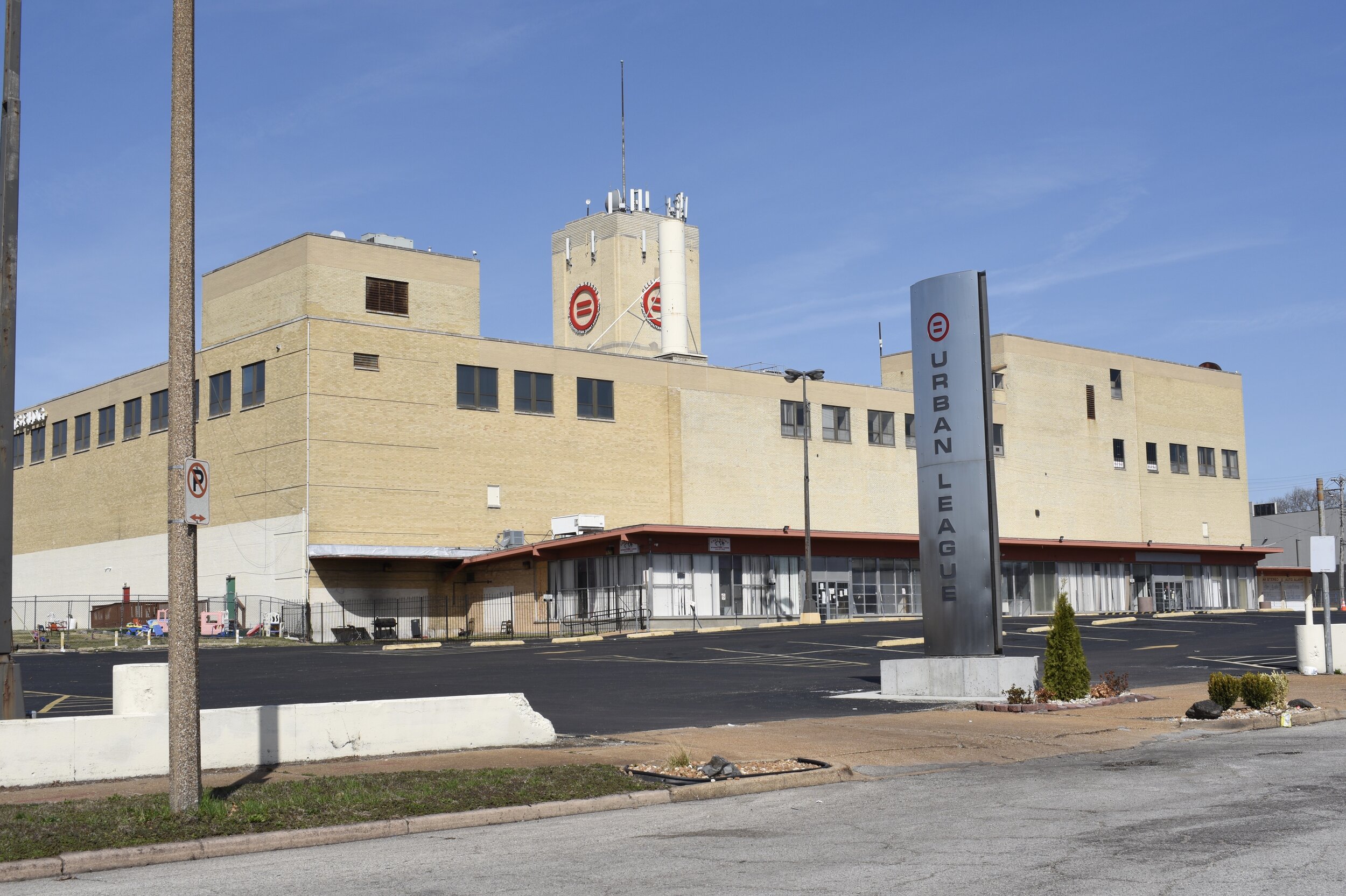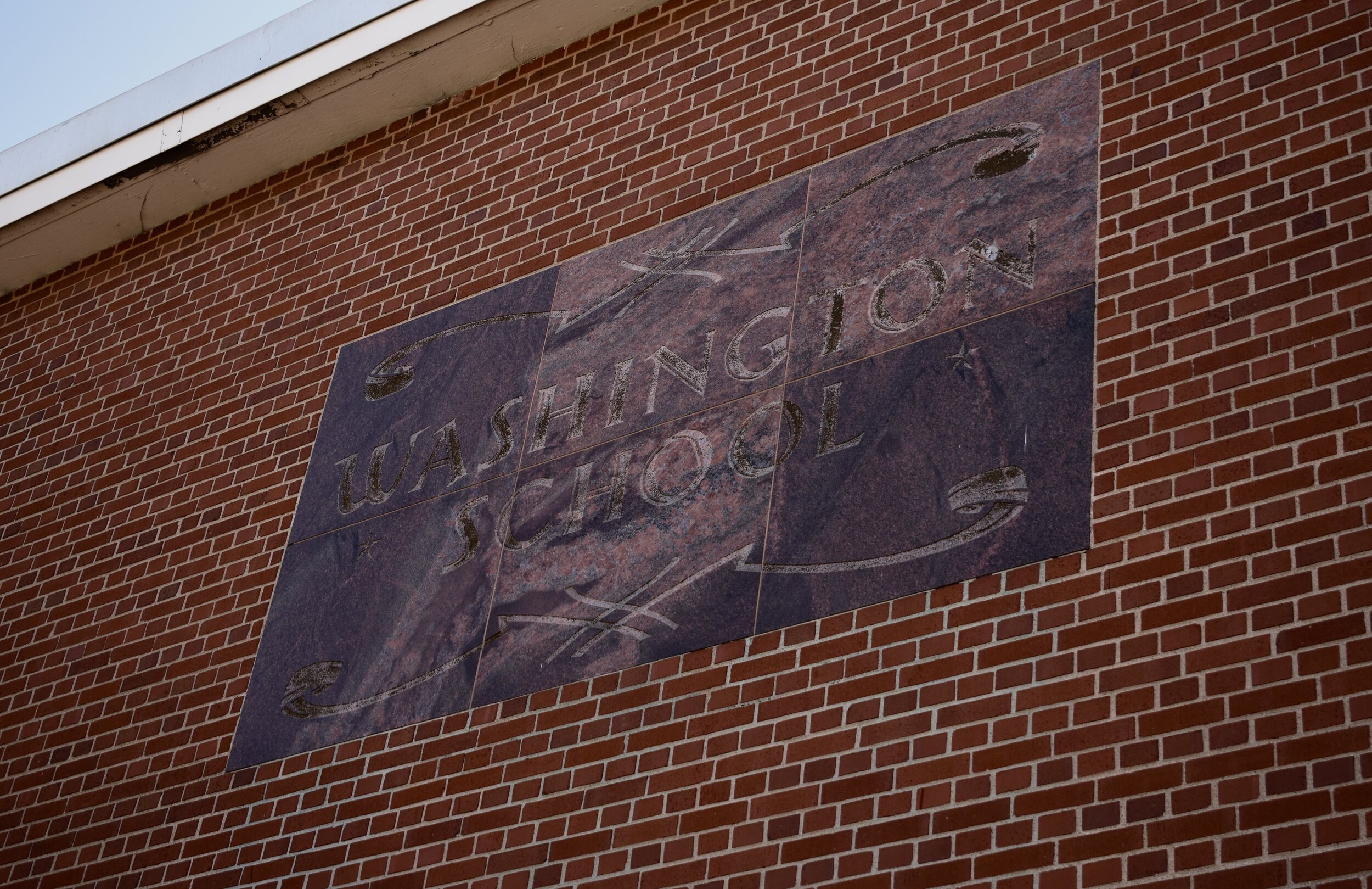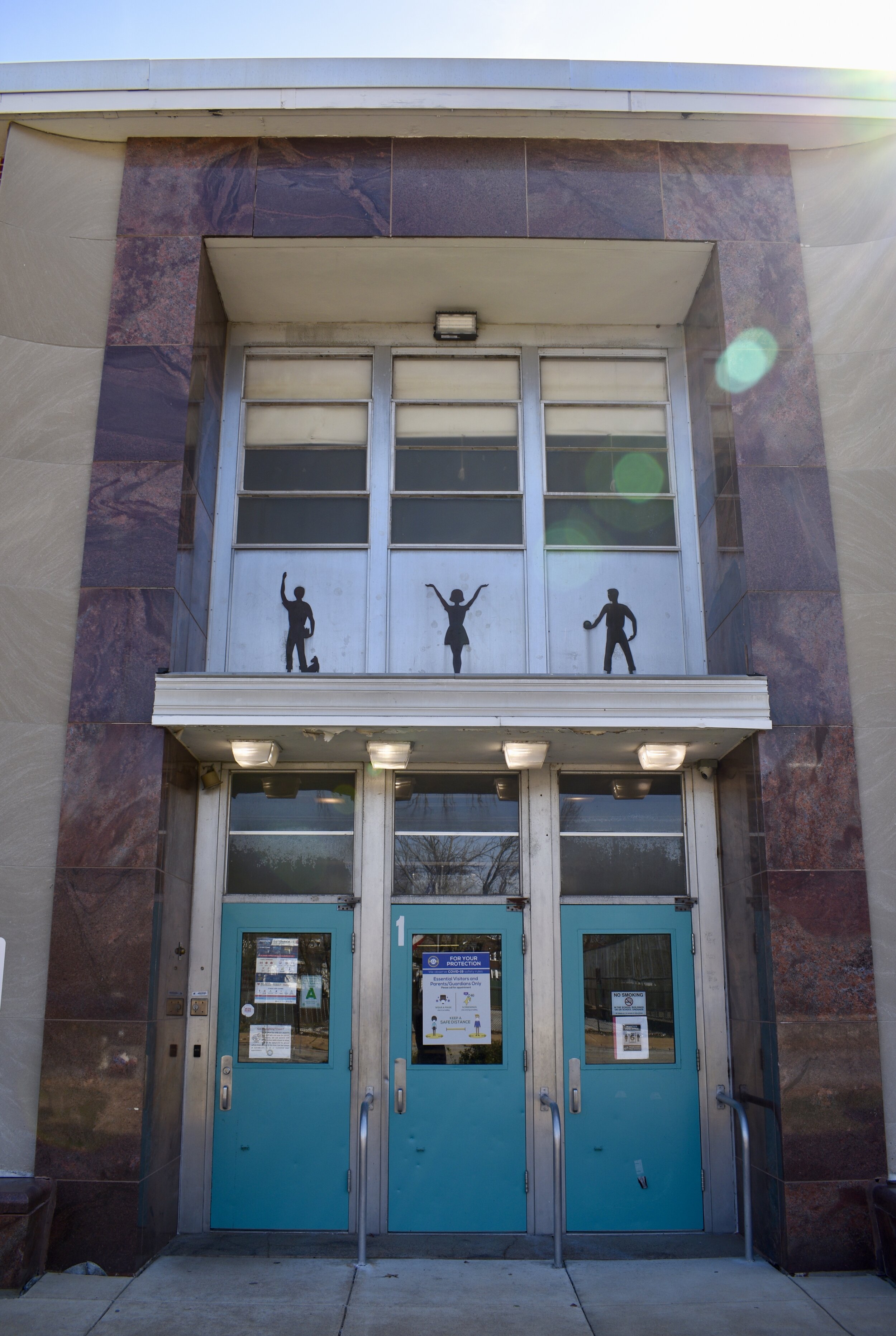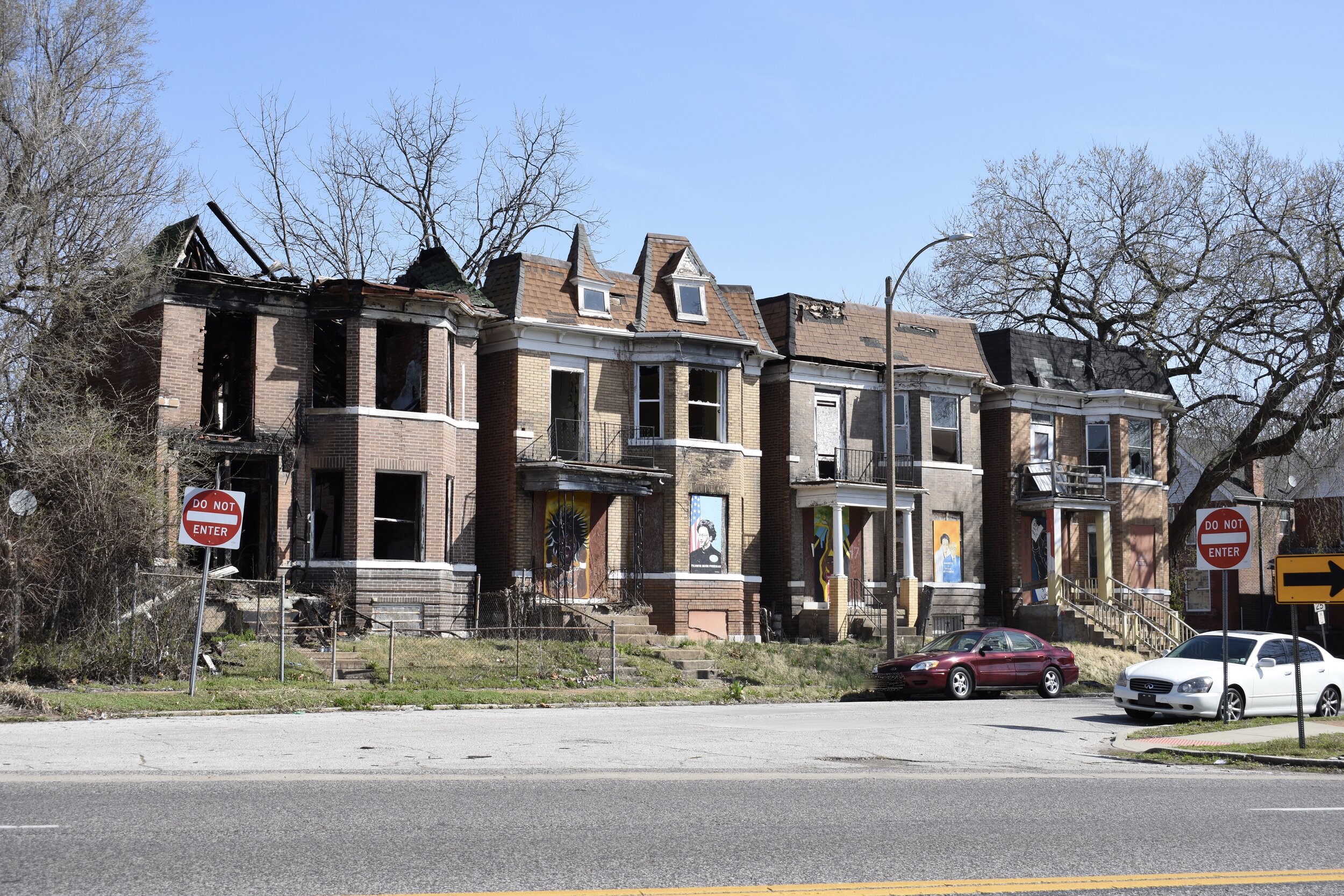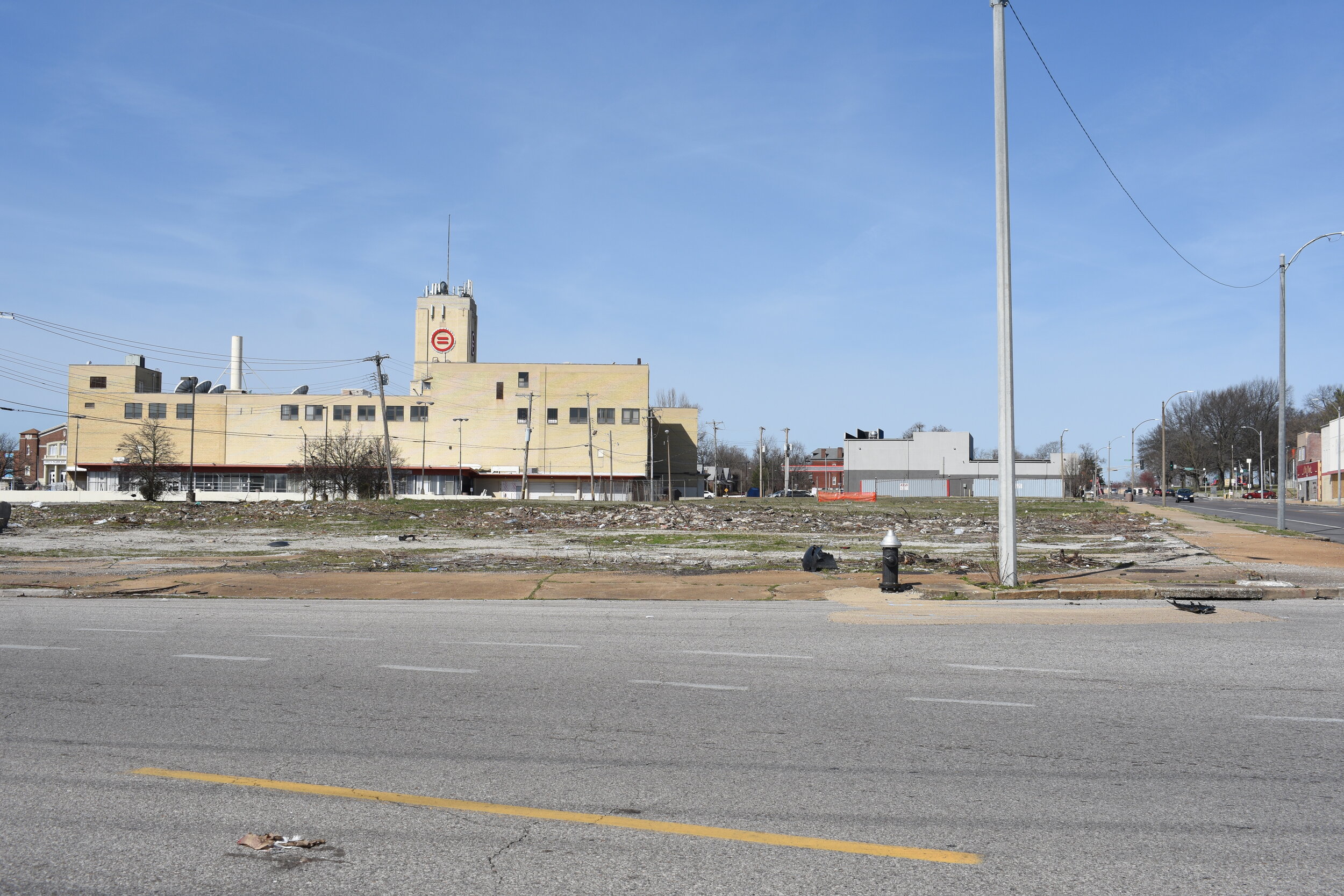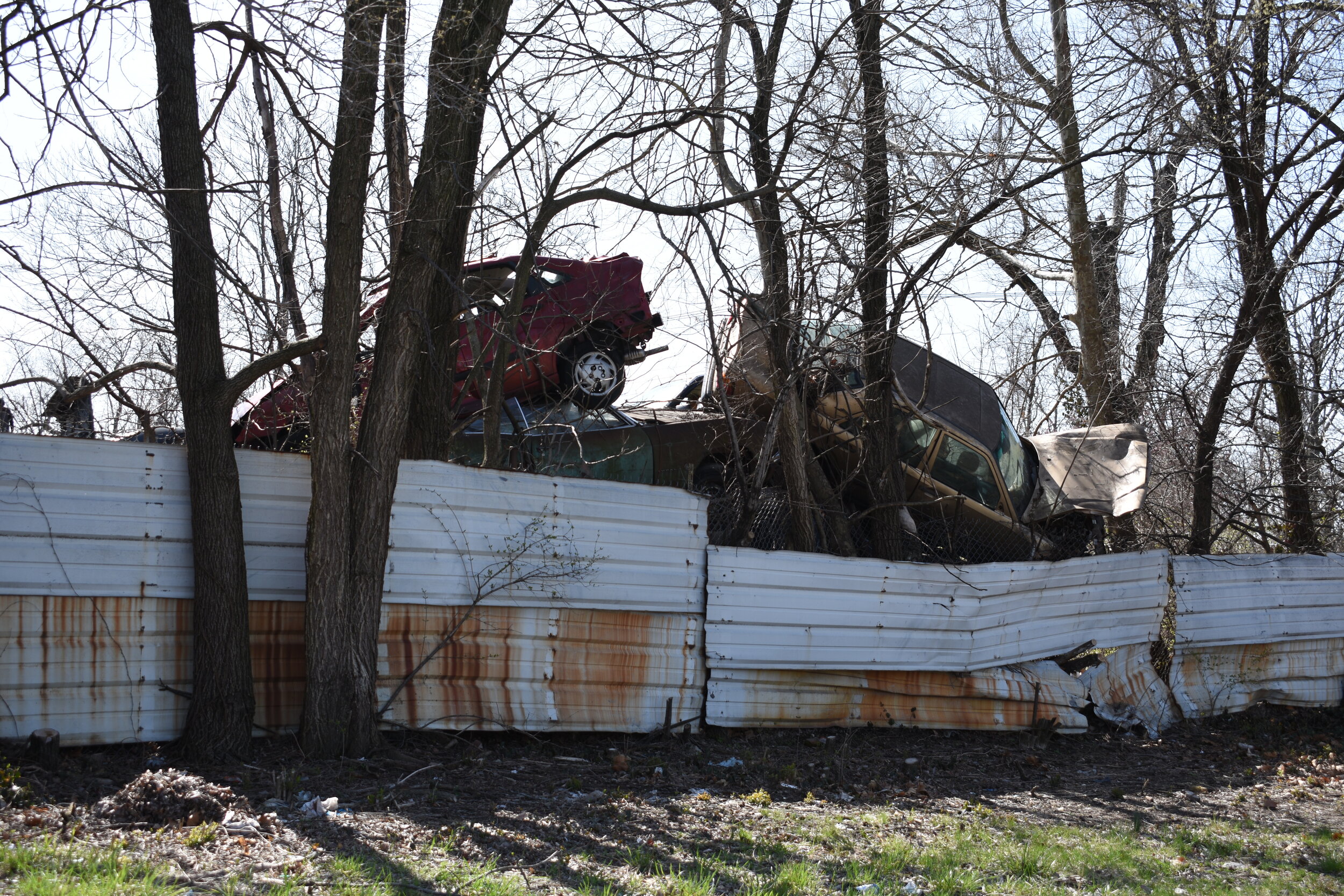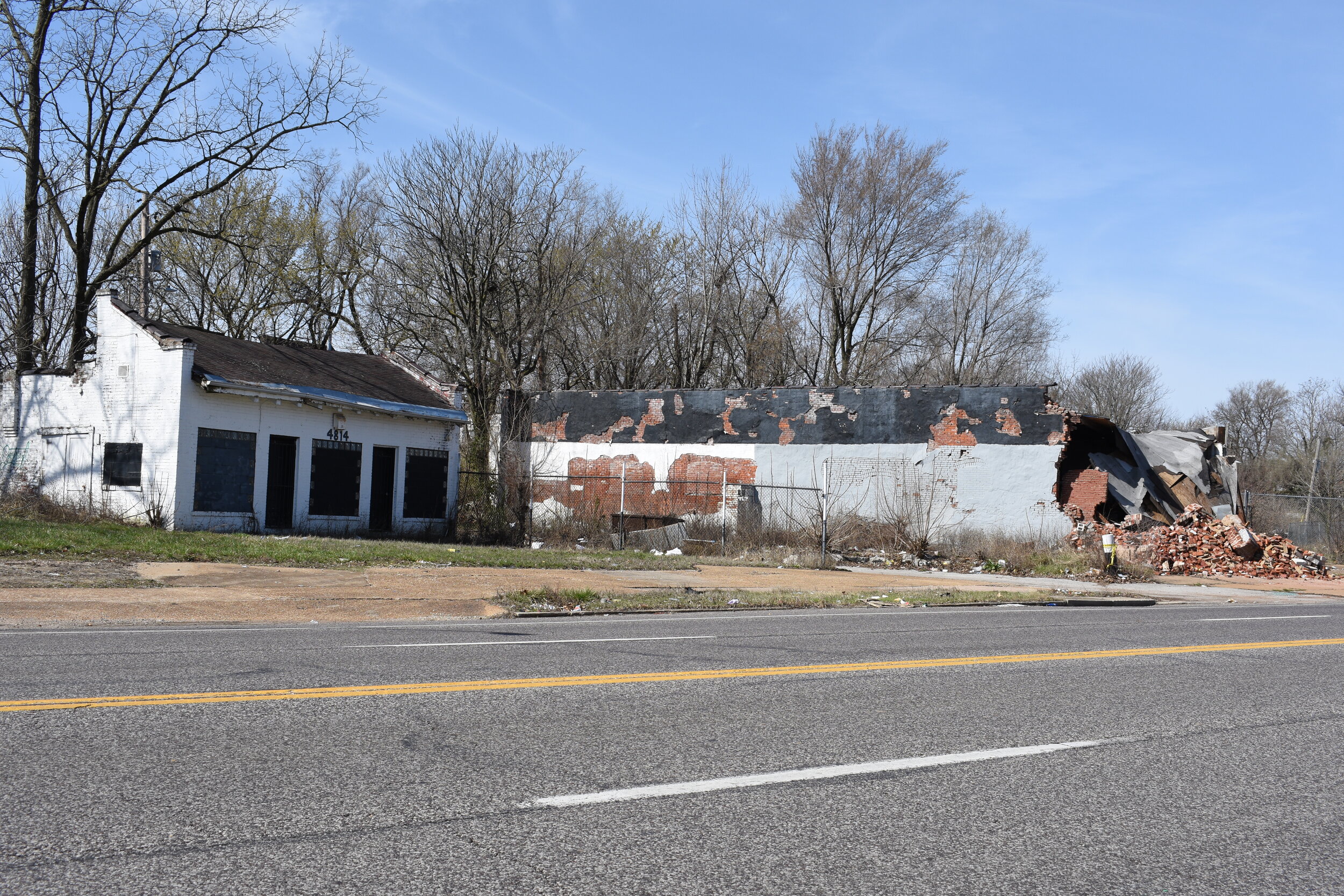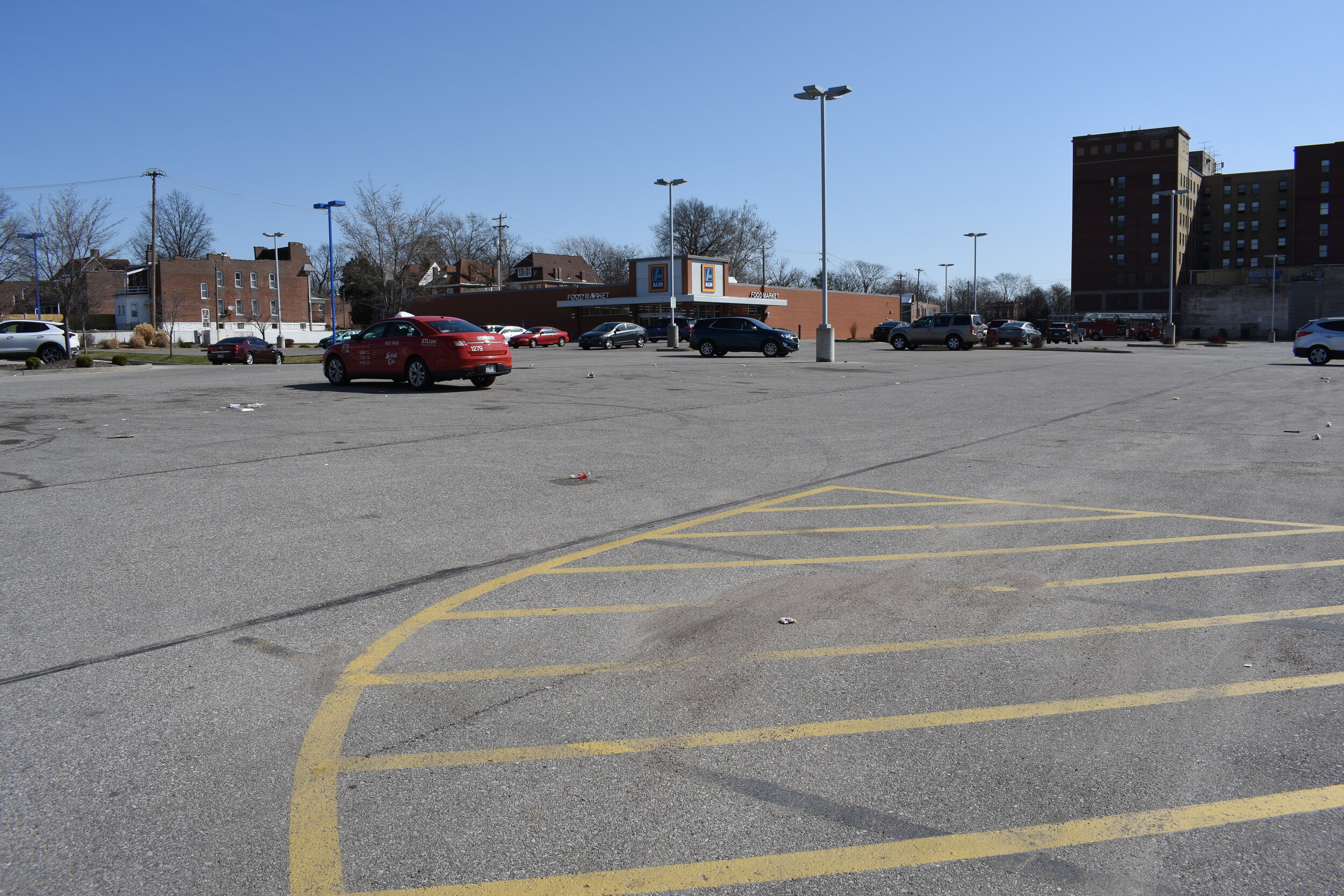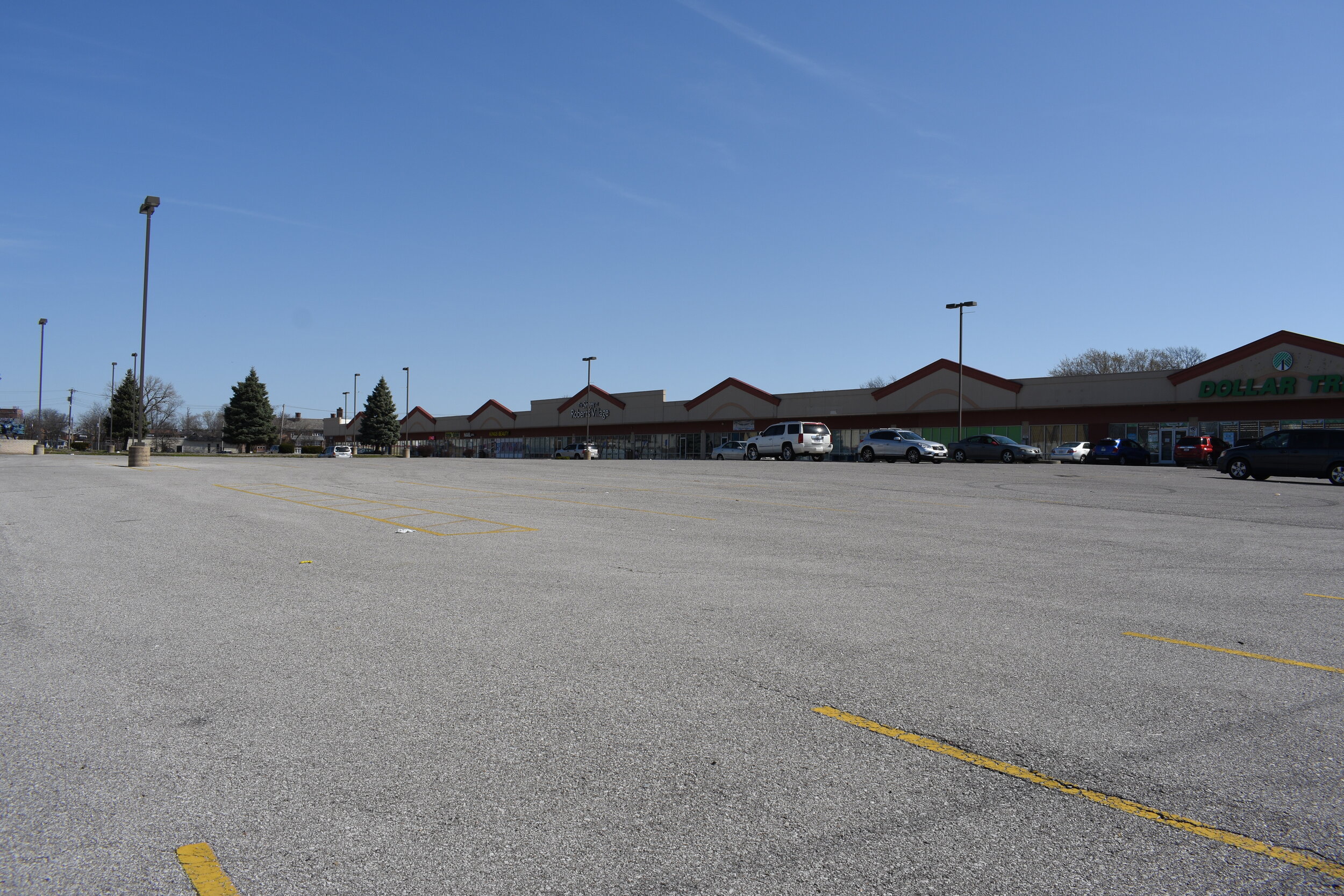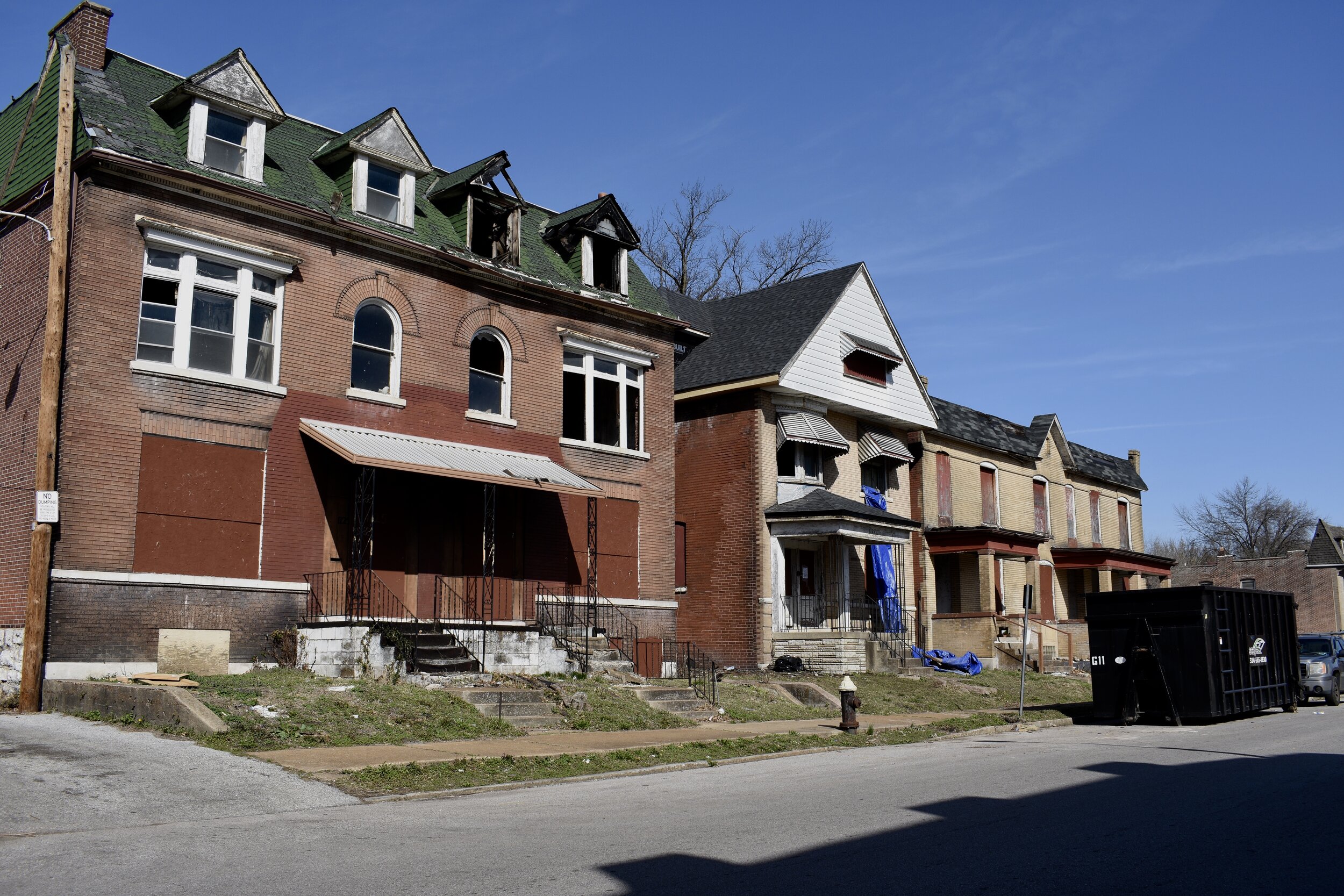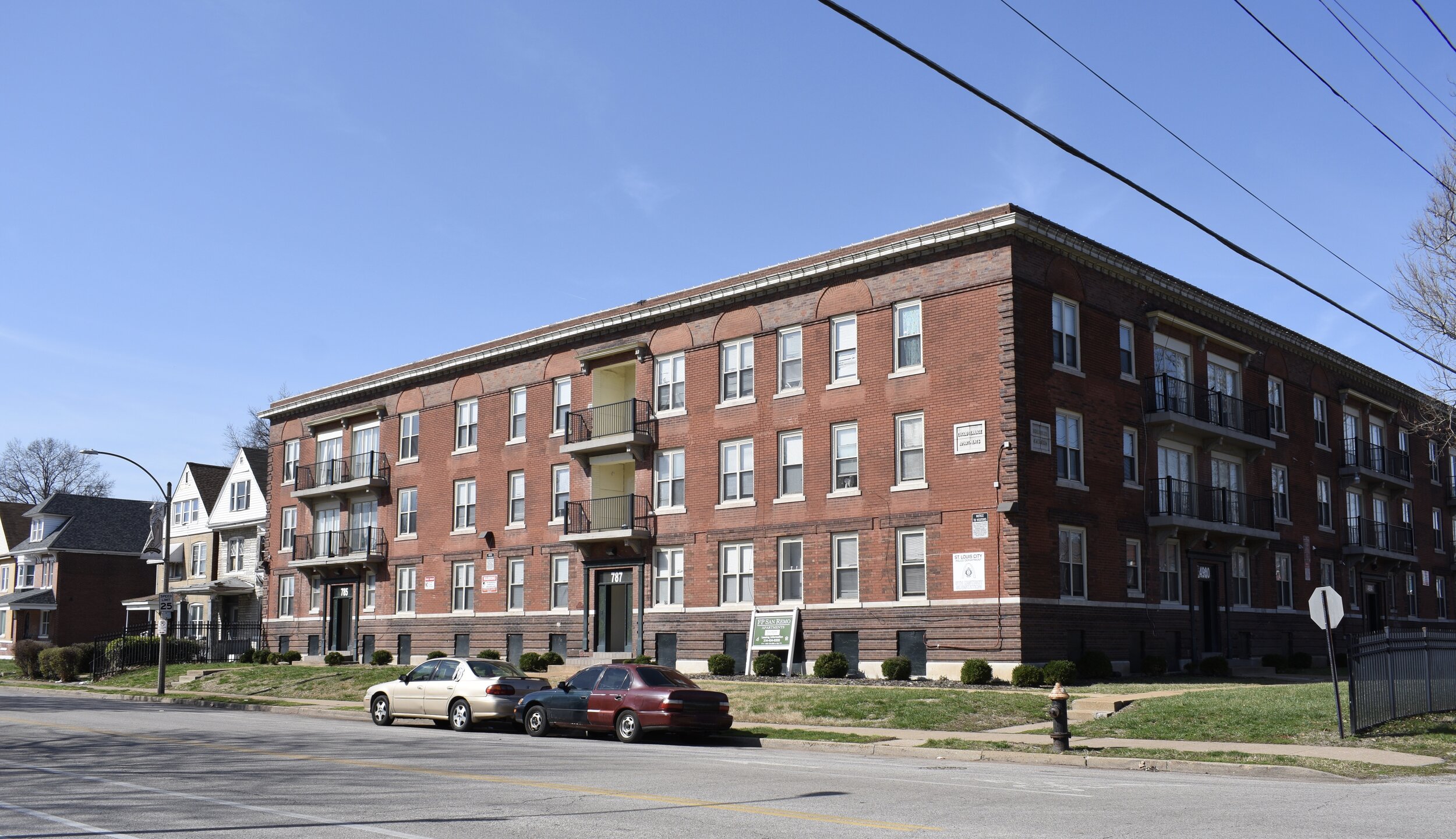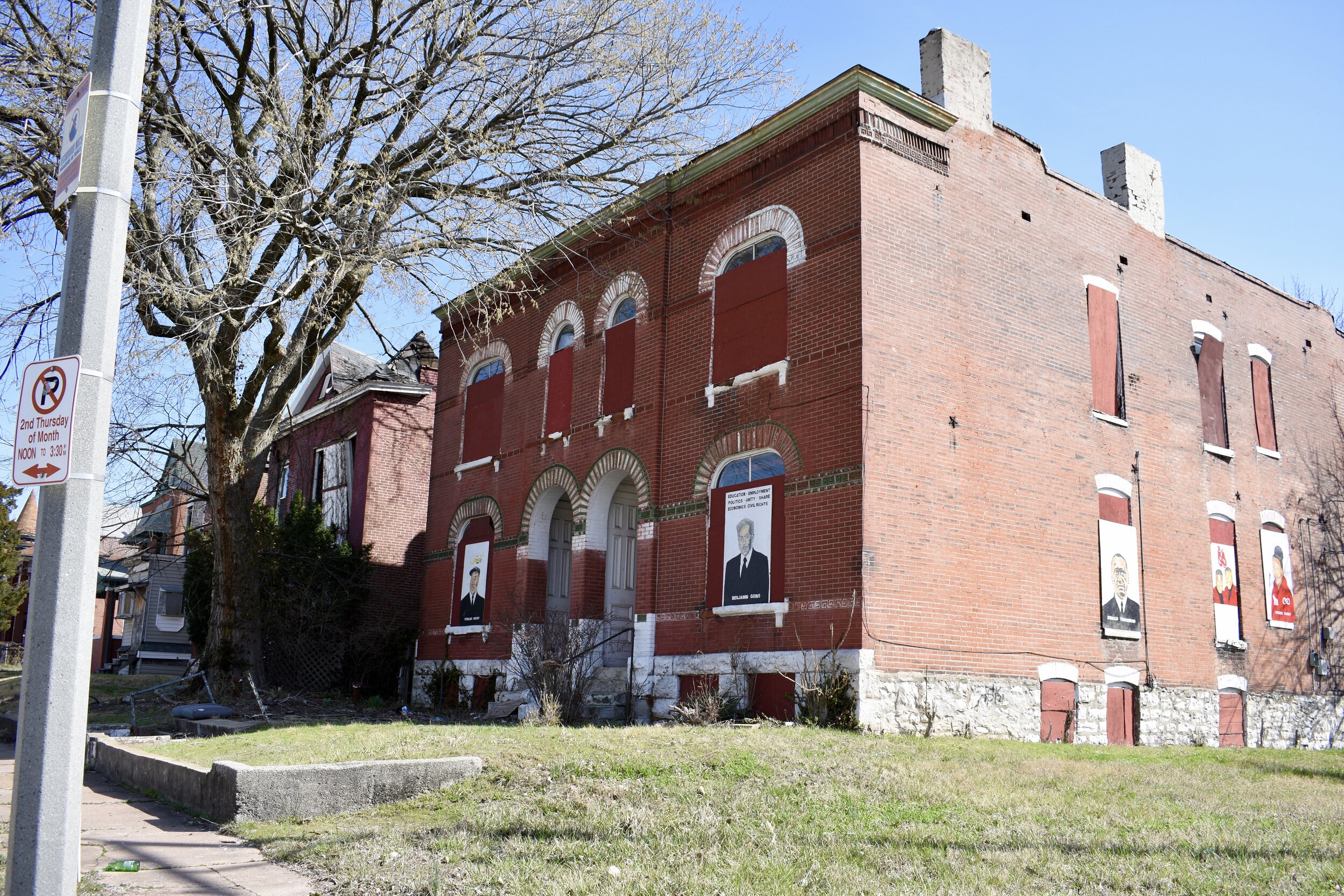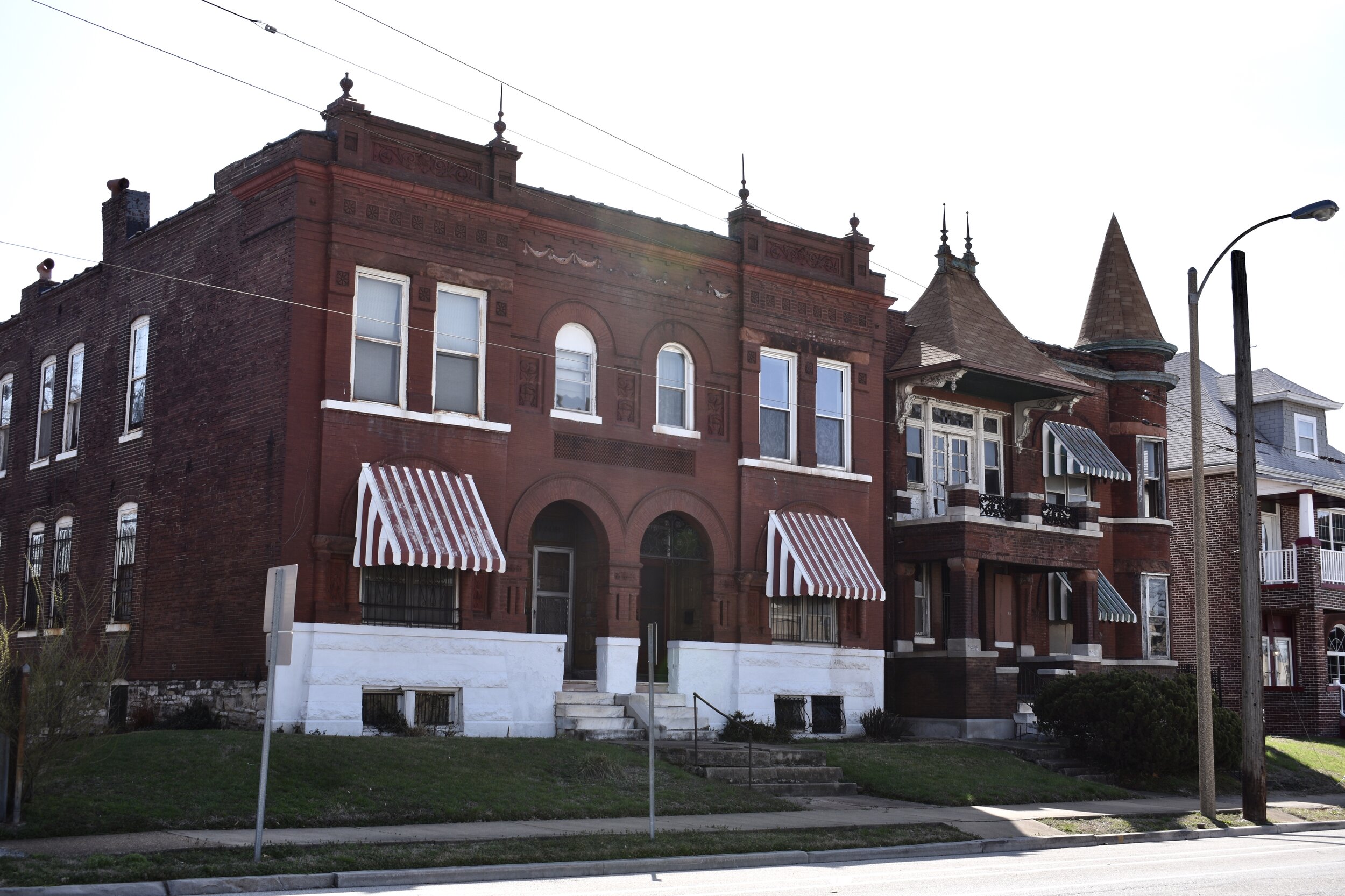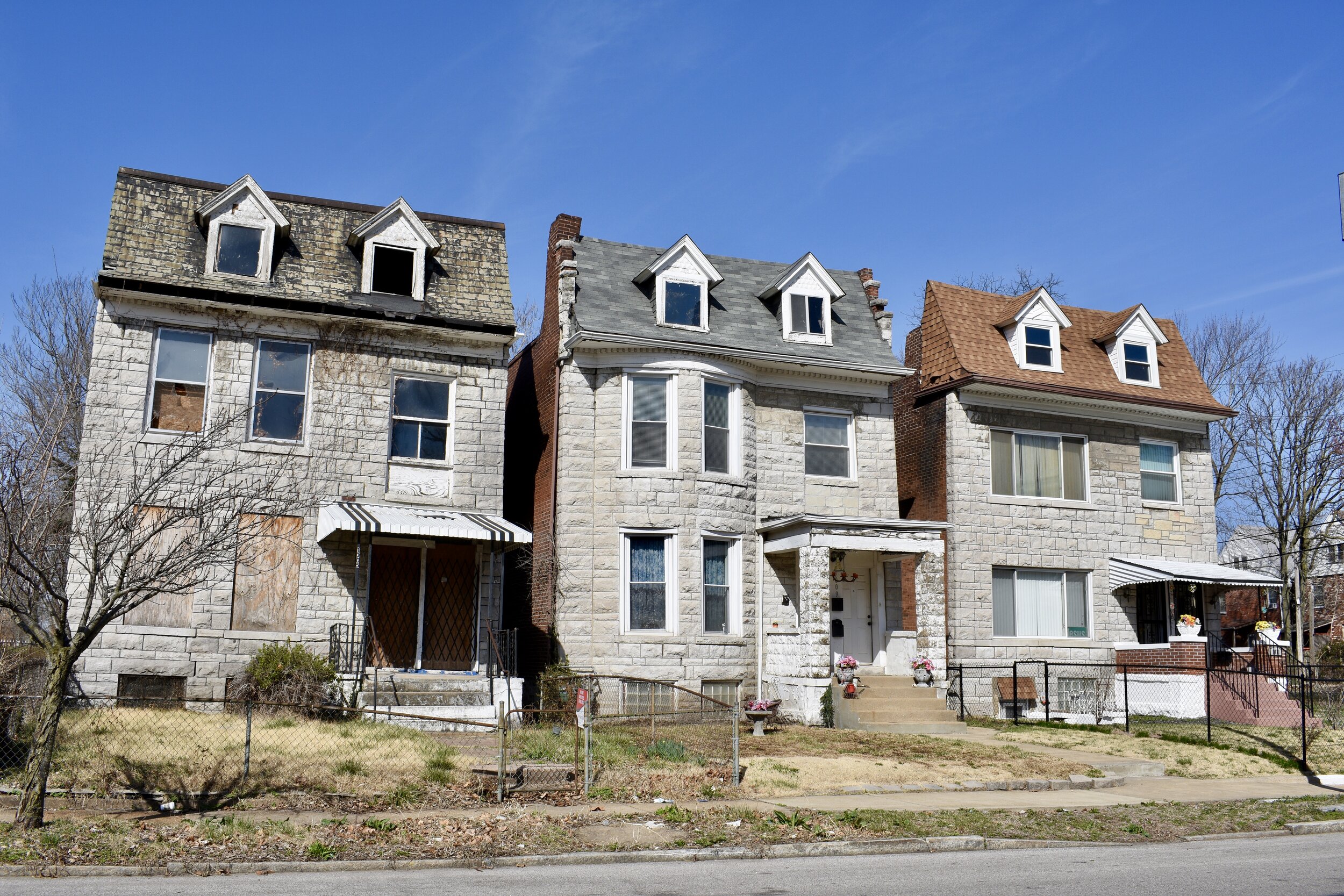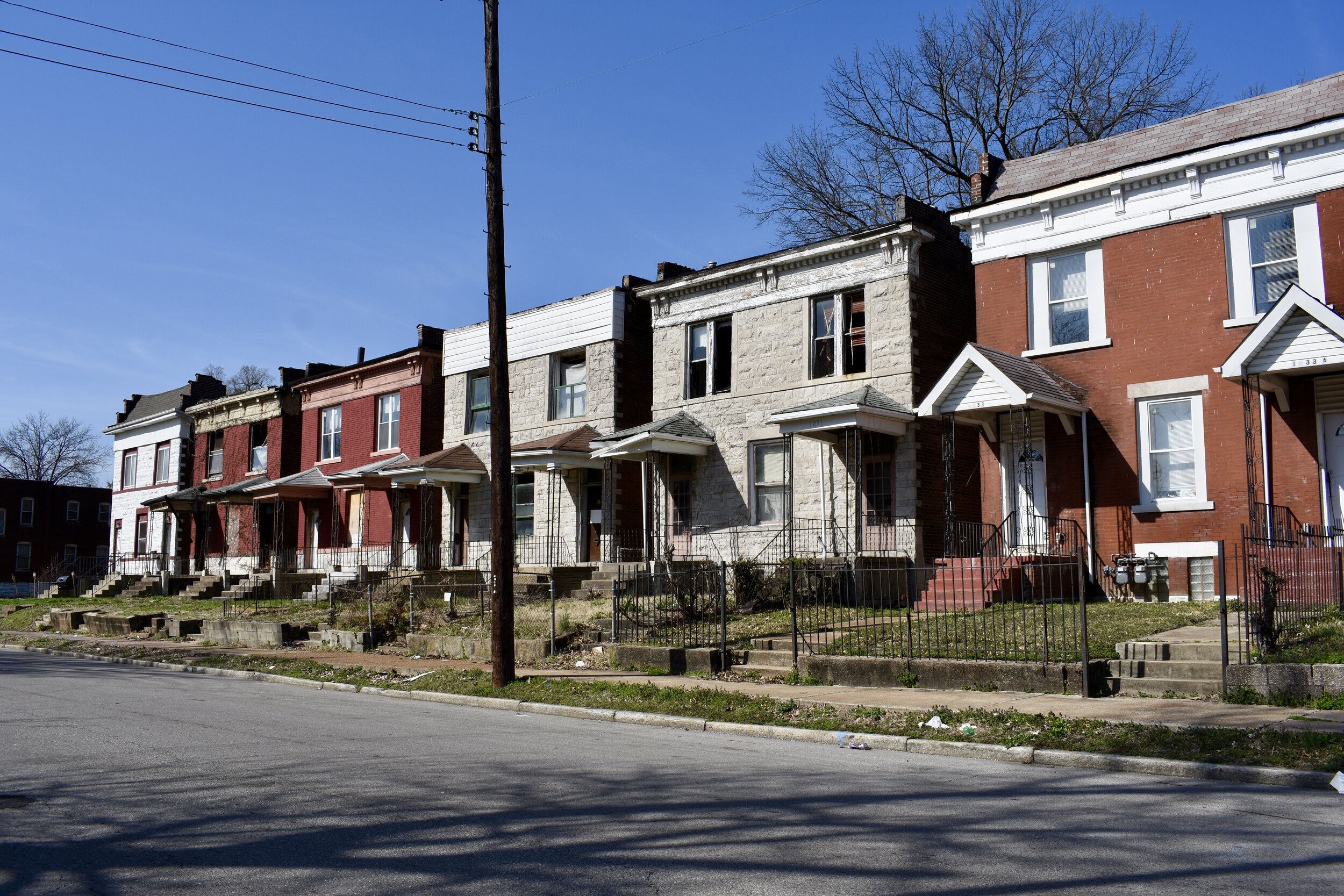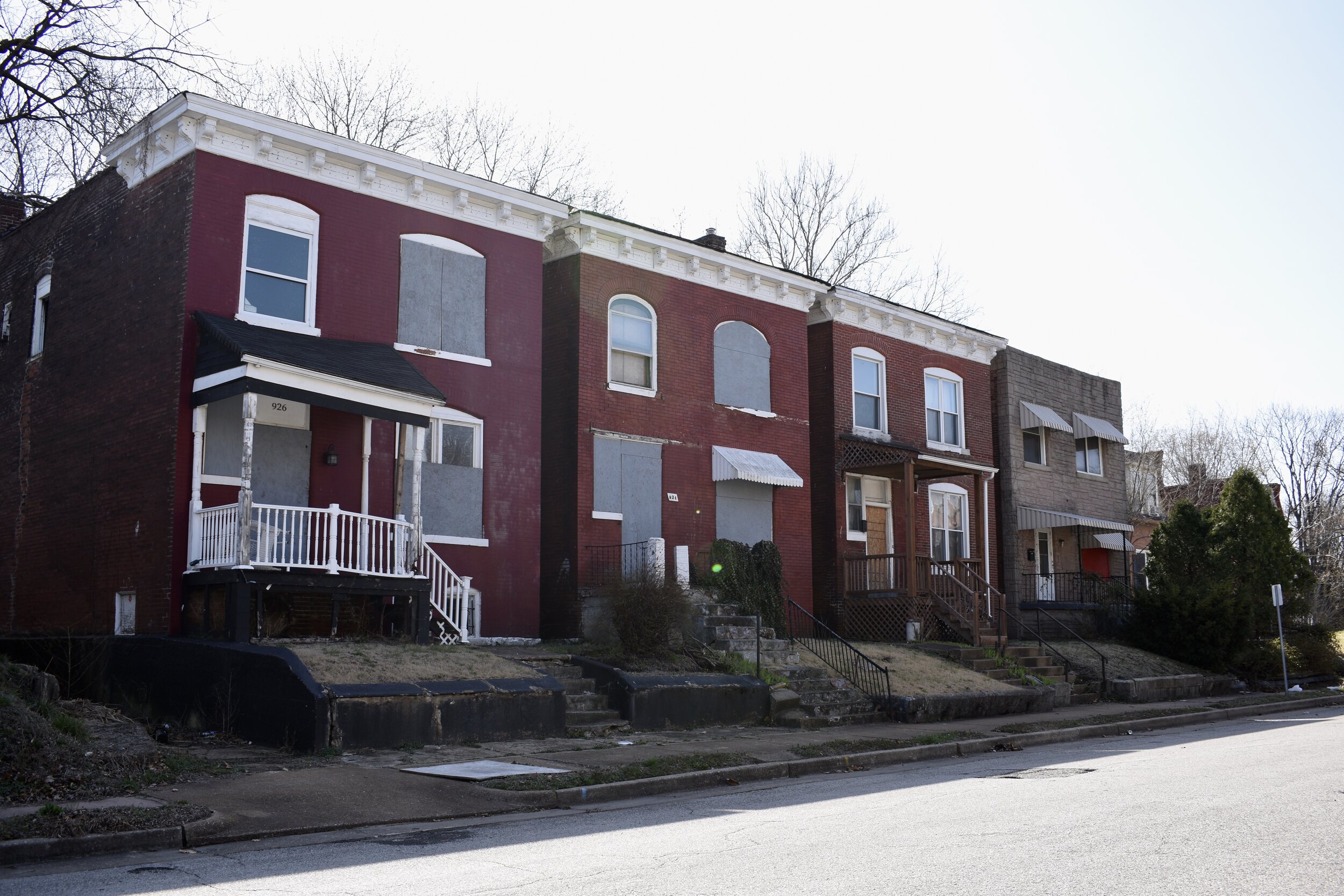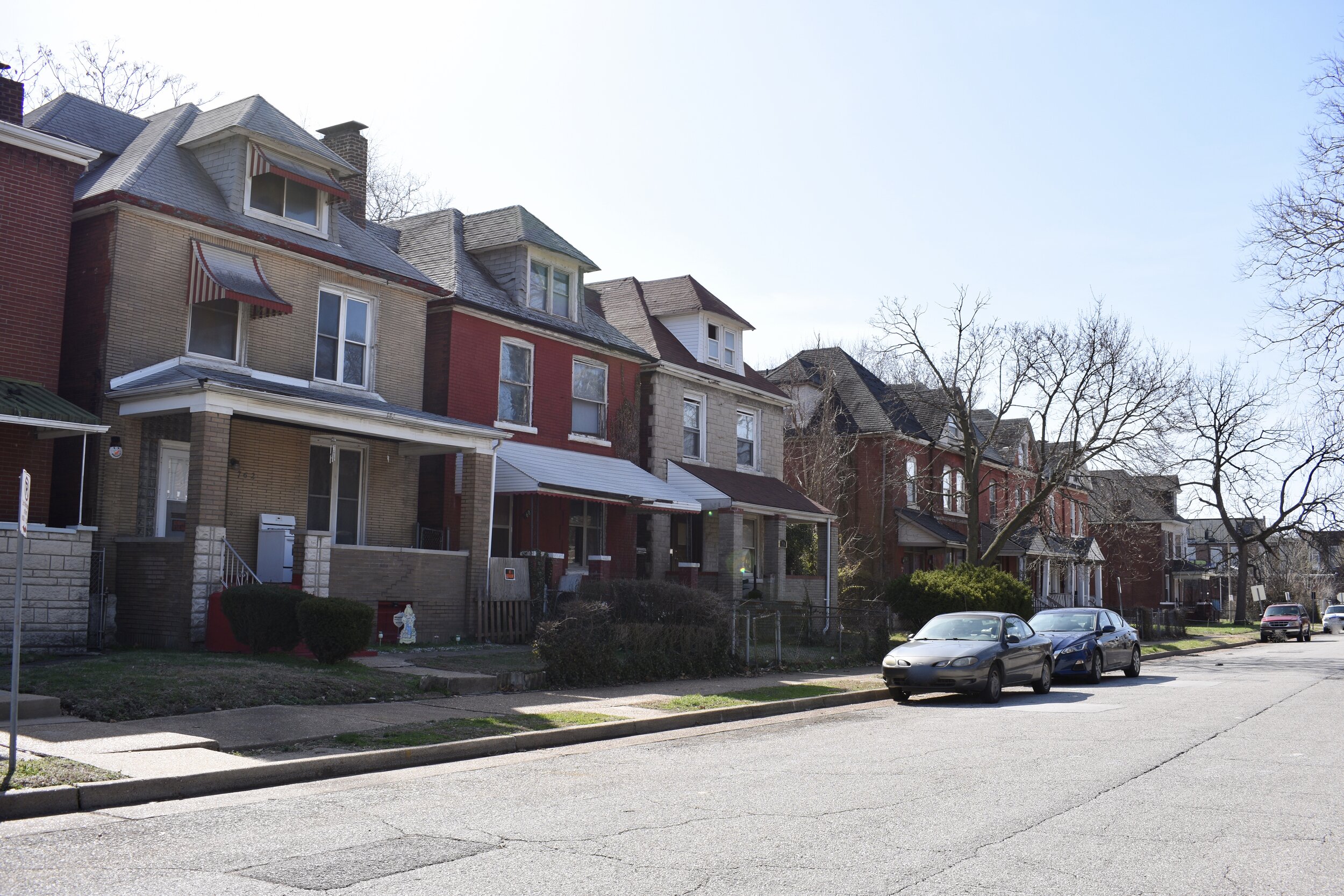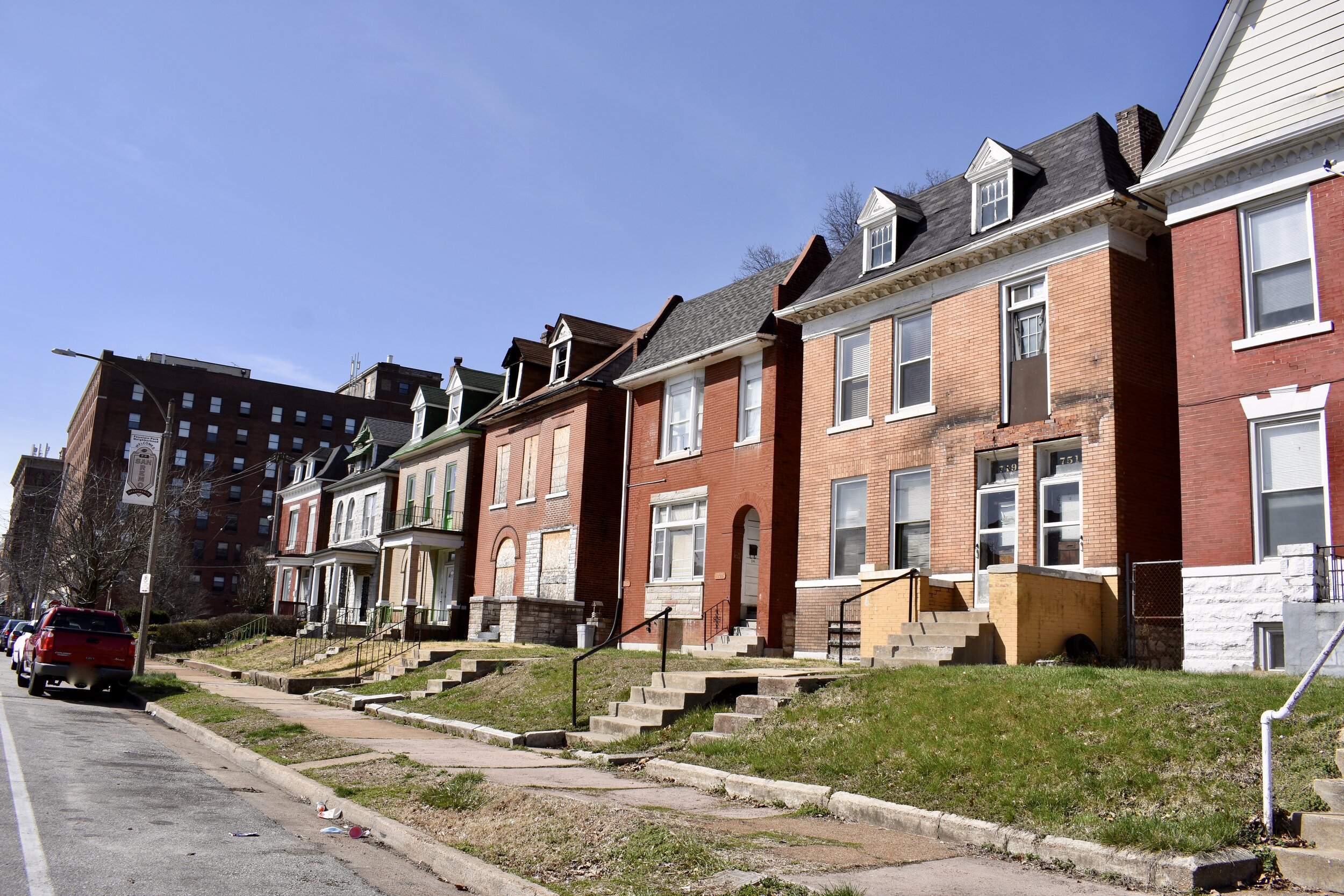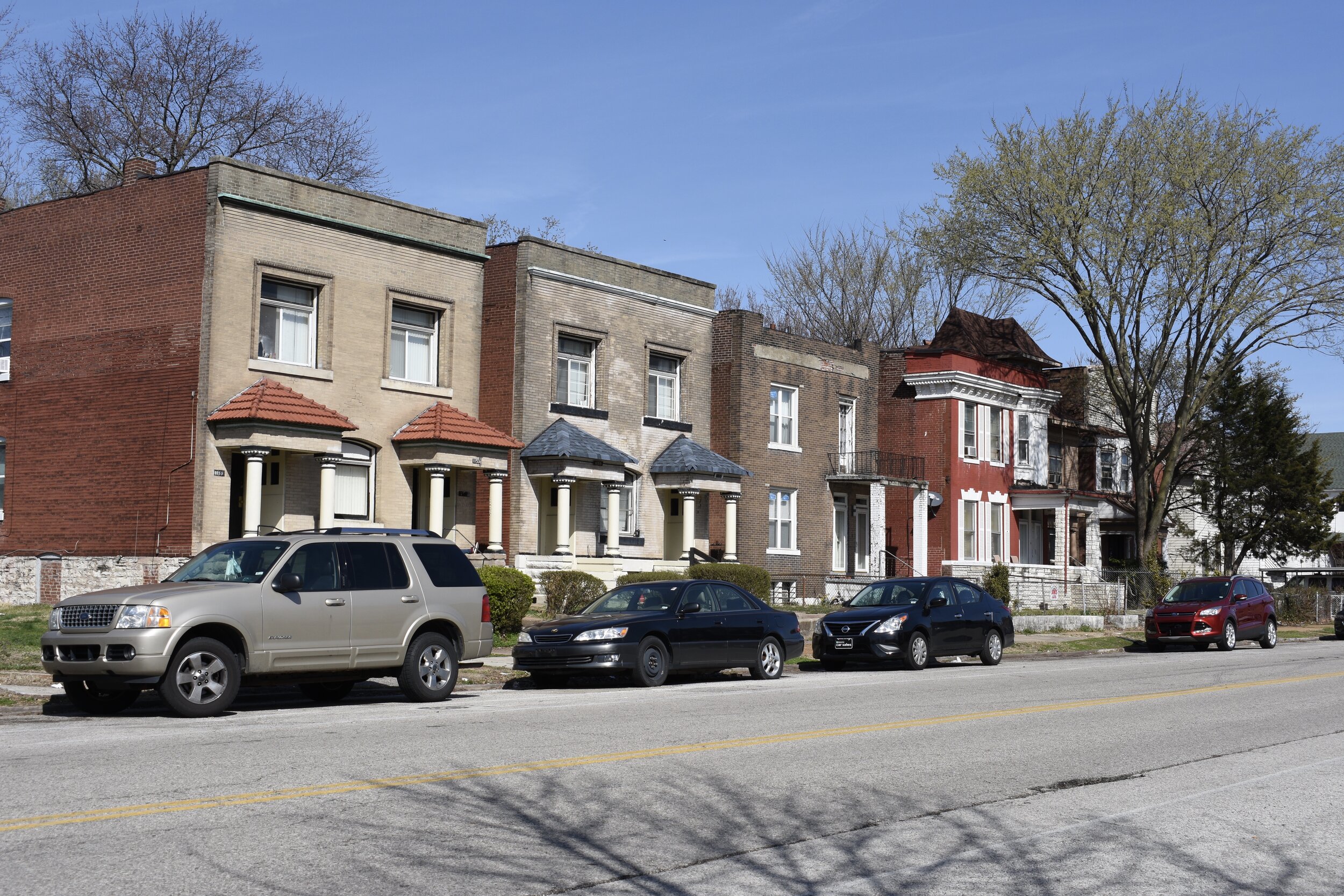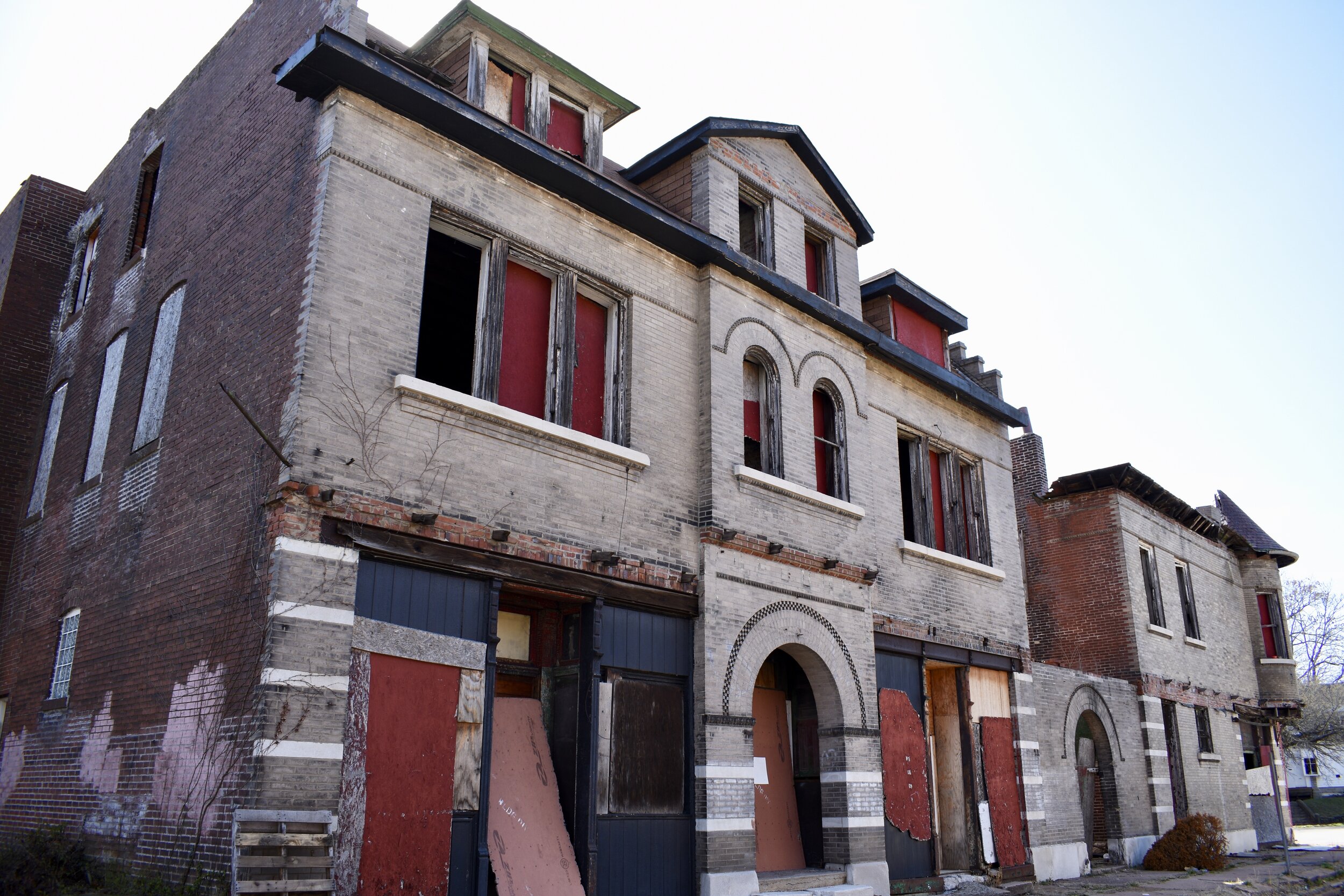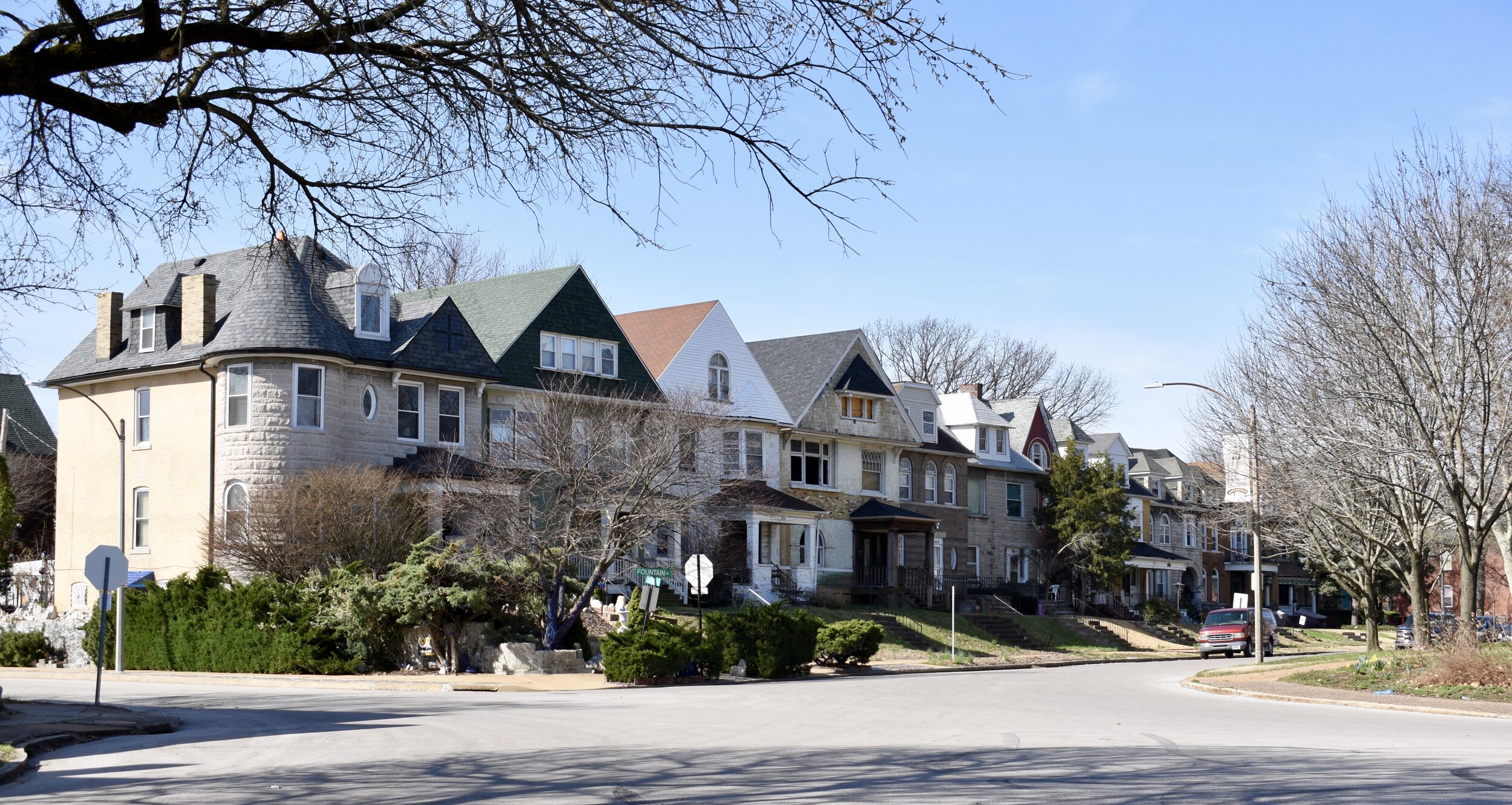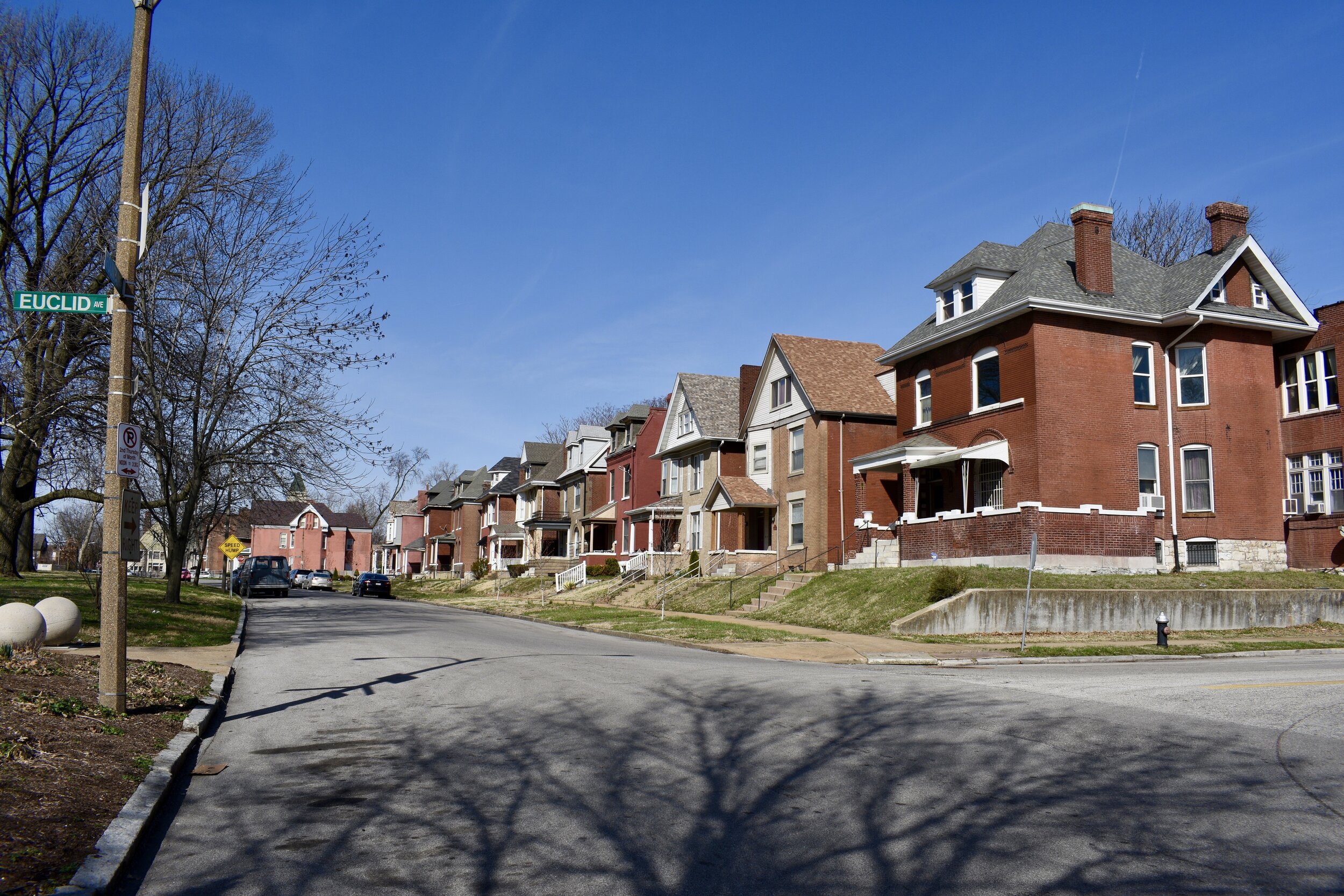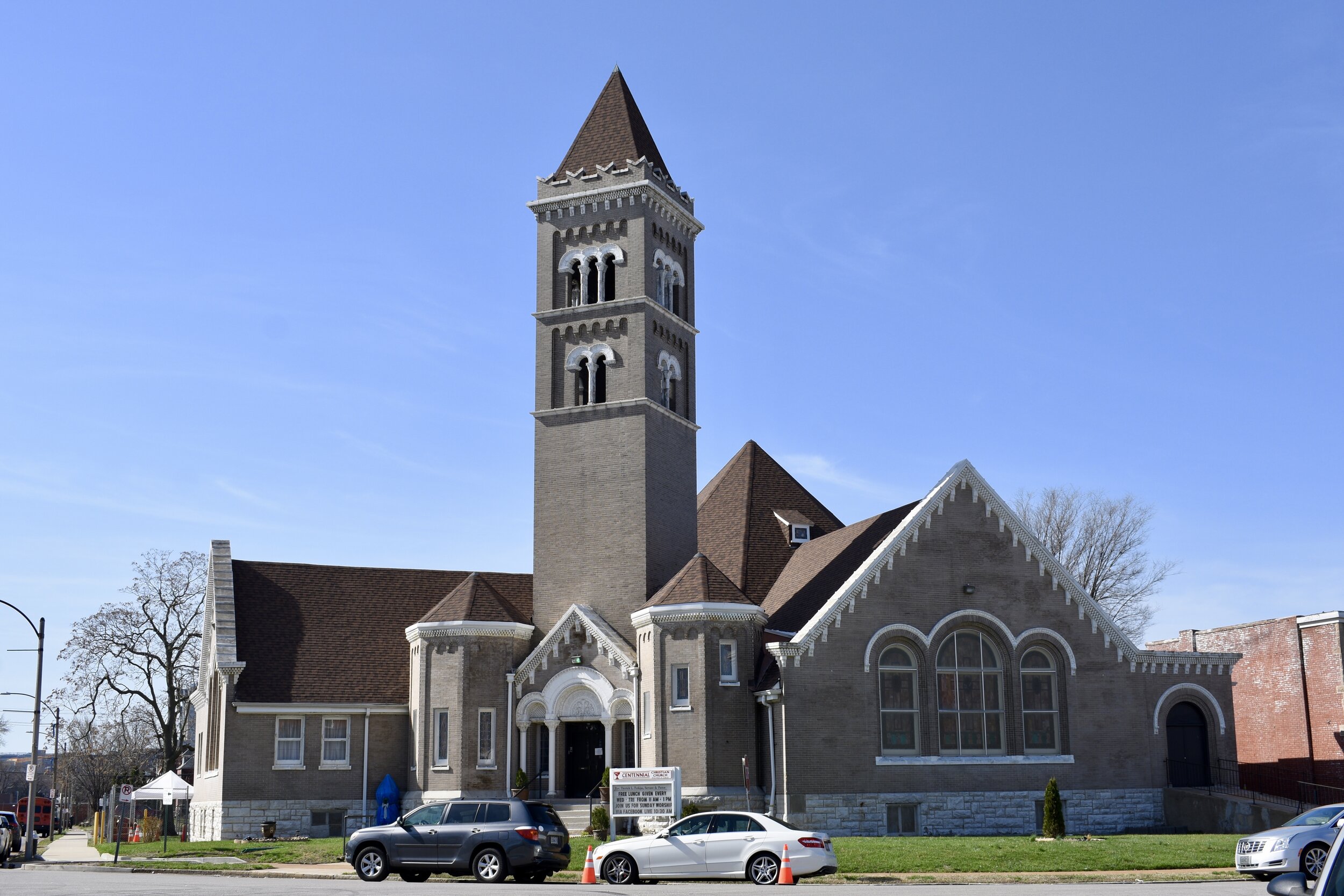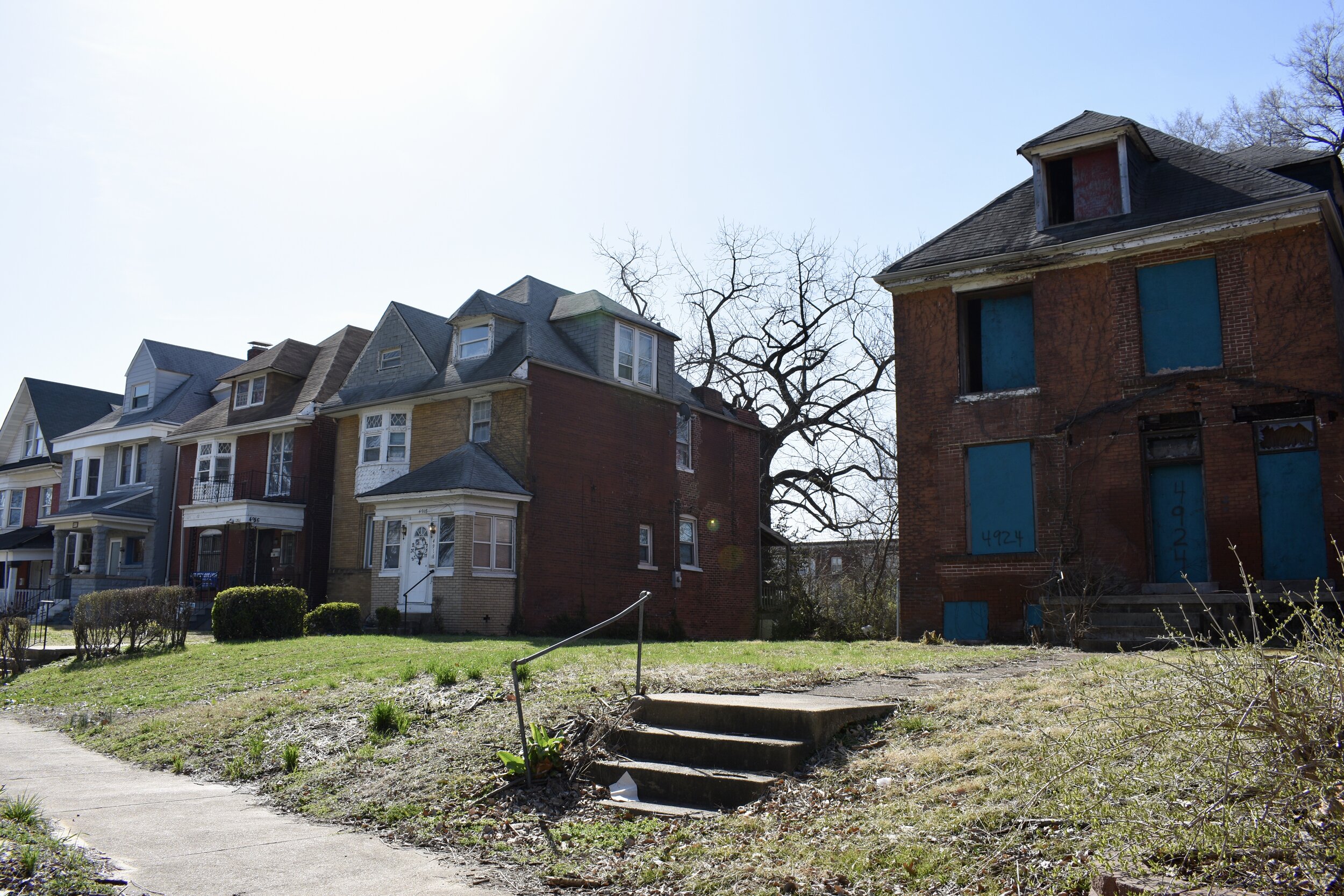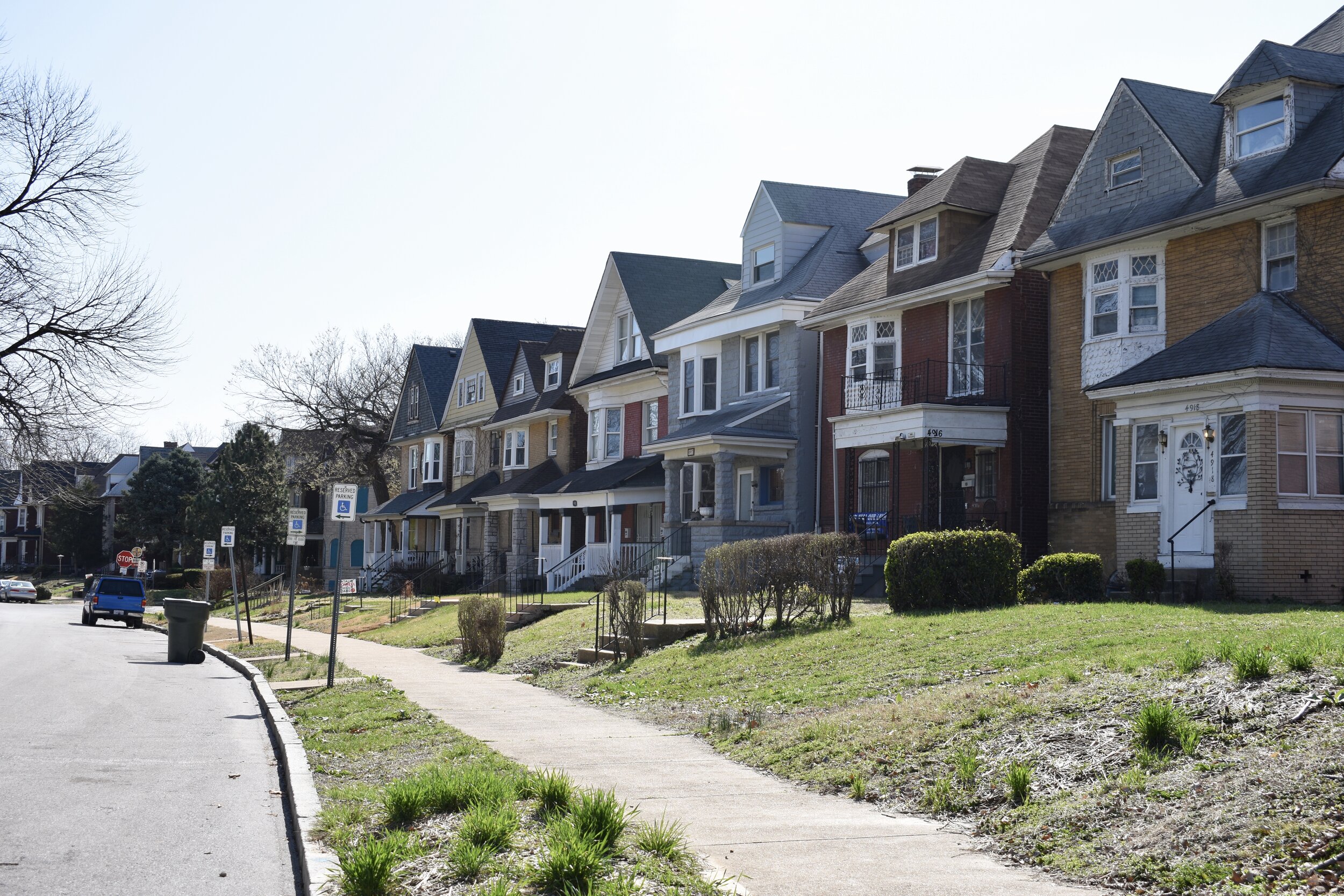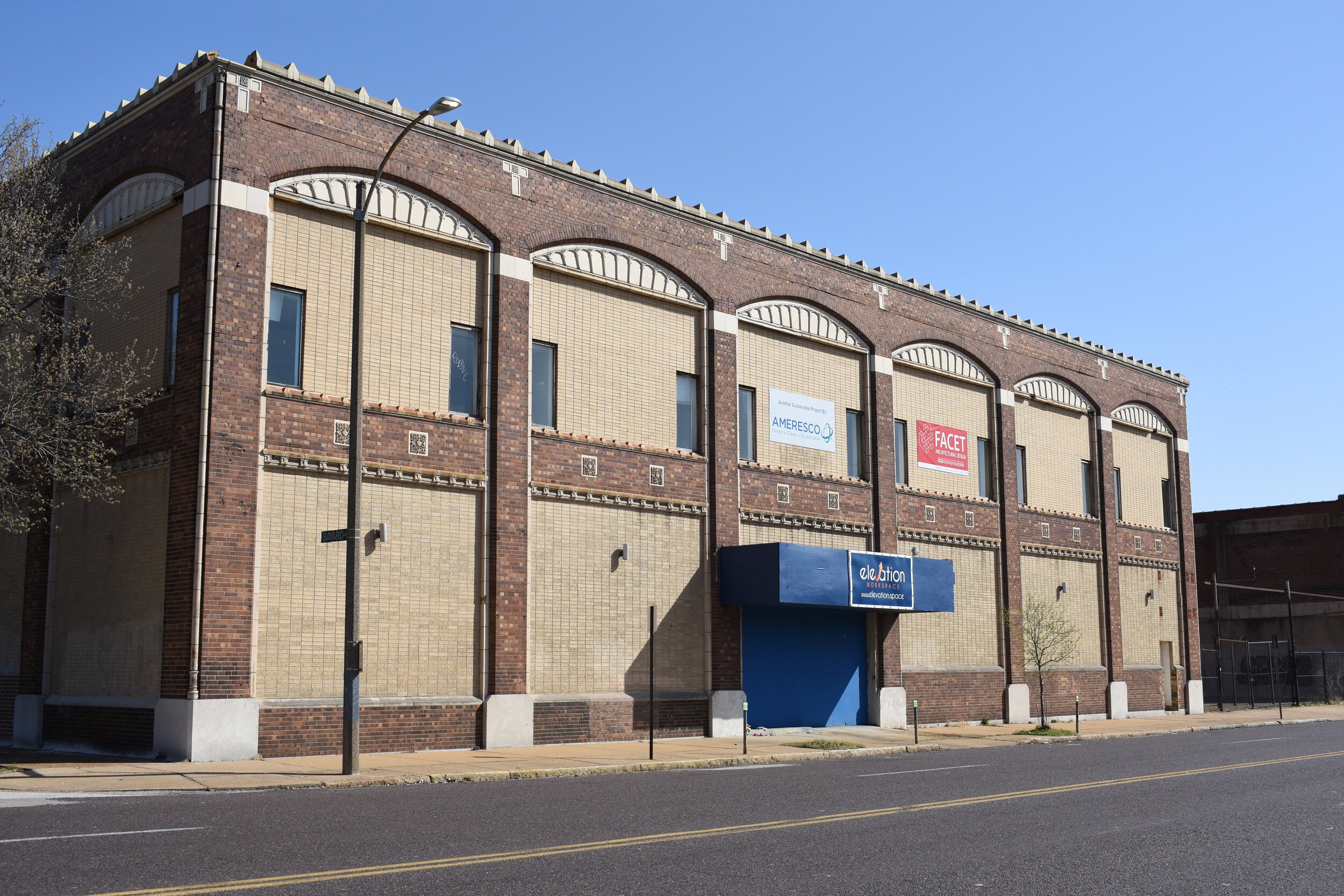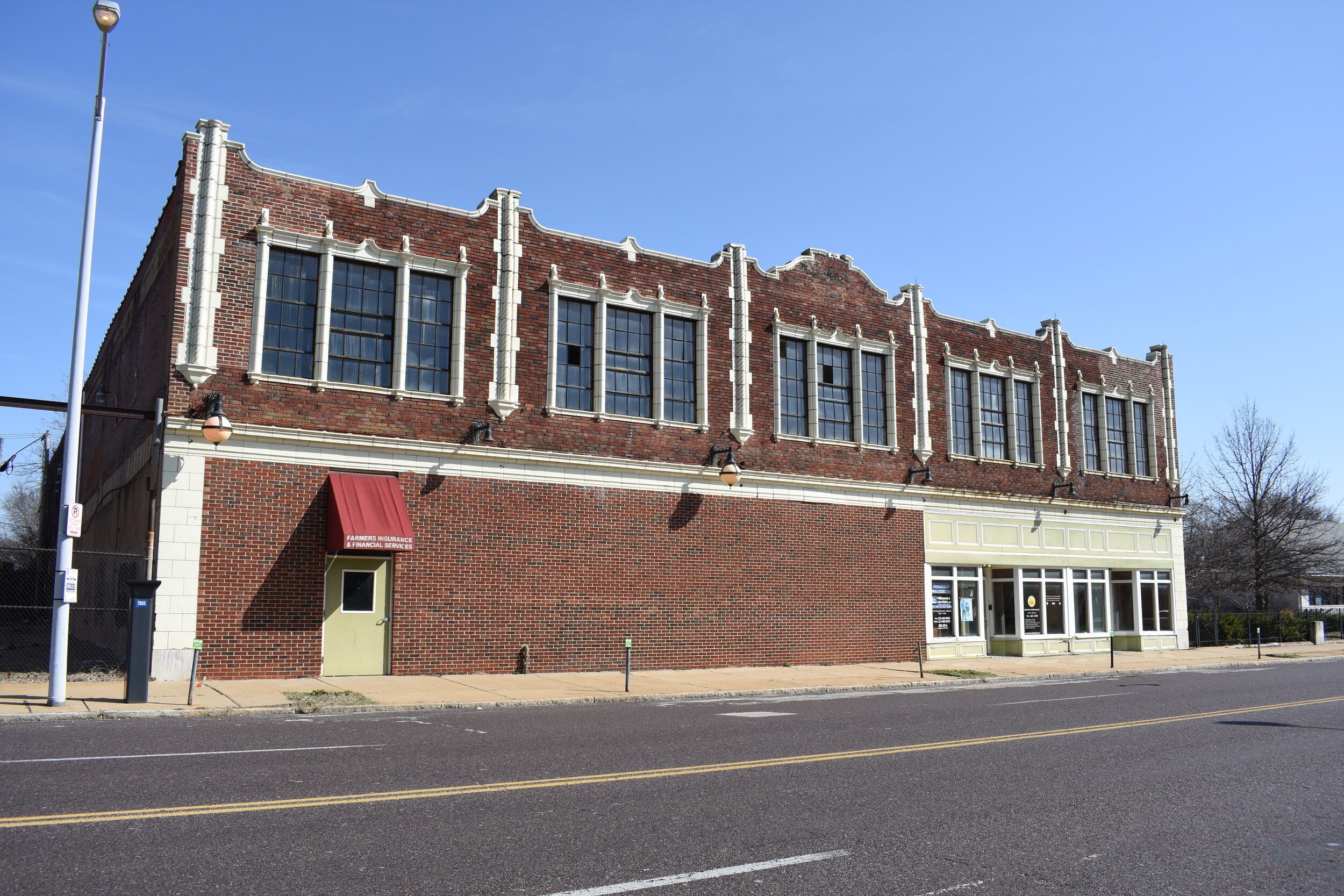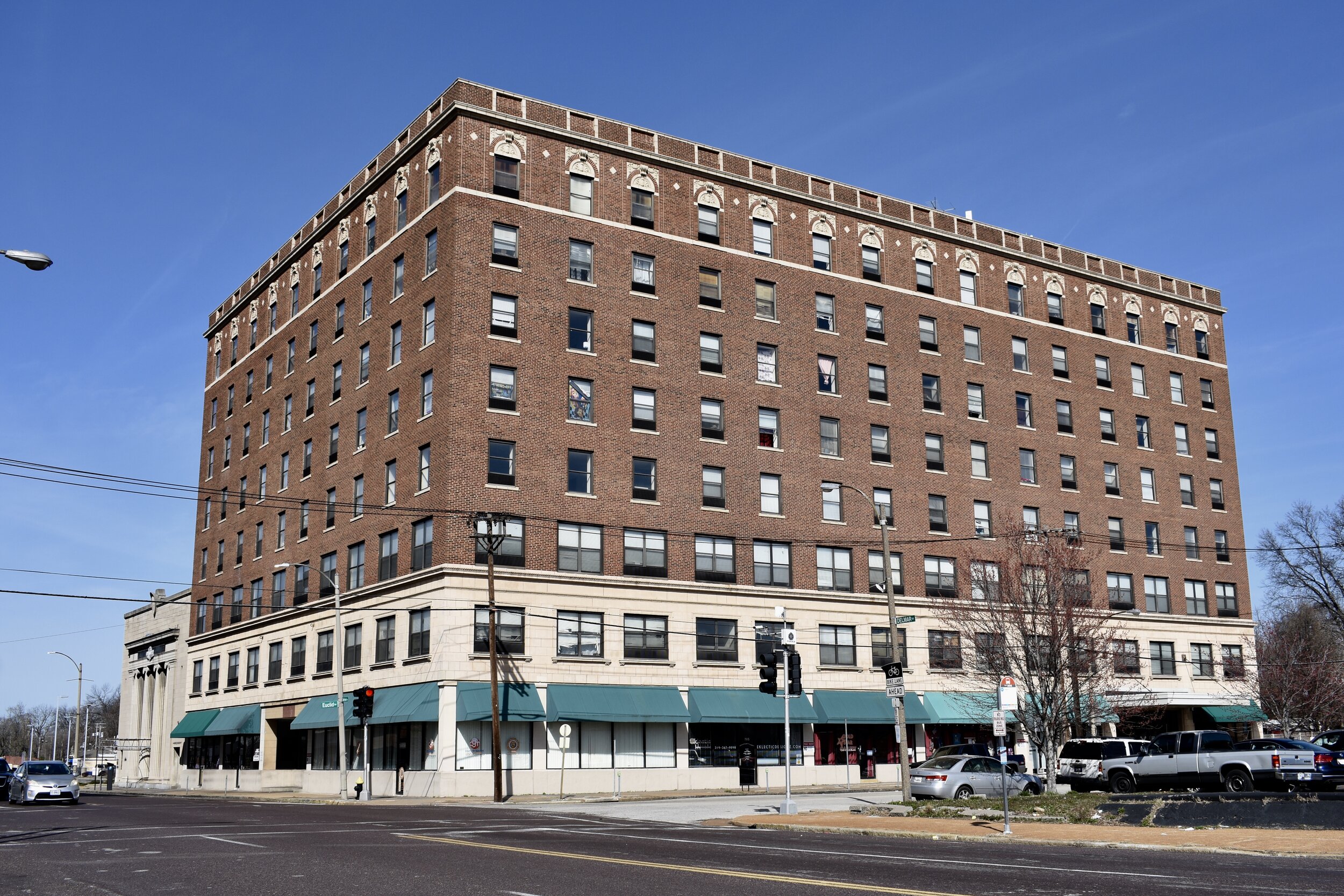Fountain Park is a north St. Louis neighborhood bound by Dr. Martin Luther King Drive to the north, Delmar Boulevard to the south, Kingshighway Boulevard to the west and Walton Avenue to the east:
The 2000 census data counted 1,804 residents (down 23% from 1990's count) of whom 99% were black. There were 1,010 housing units counted, 75% occupied (32%/68% owner/renter split). 2010 census data counted 1,484 people, another 18% loss, down to 17 white people, 1,445 black people, 7 Hispanic/Latino and 1 Asian.
From the Fountain Park website:
The Neighborhood is renowned for large stately houses, accessible shopping, convenient transportation, schools and numerous black churches within a stable community. Neighbors have organized and formed block units and neighborhood associations designed to maintain and improve the culture of the area. Two of these organizations are: The Enright Neighbors, and the Fountain Park Block Unit.
The homes are regularly maintained. A few of the homes have been secured by private developers for rehab. These homes are available to potential neighbors, interested in becoming a part of the history of a solid family orientated neighborhood. Neighbors regularly gather to improve the neighborhood and support each other. They participate in the Operation Brightside clean-up and the National Night Out.
"Stable community" are not words that could be used to describe current day Fountain Park by most objective people. I must admit this is my second attempt at photographing this neighborhood. To make a long story short, I was convincingly asked to get the #$%& out the first time. The drug trade is alive and well on some streets in Fountain Park and it's as obvious and out in the open as can be.

If you can't make it out, the painted message on this abandoned property reads "No Loitering, Drinking or Drugs".
I'll tell some stories later when I get done with all the neighborhood profiles and will write a post on my run ins with racism, drugs, homelessness and prostitution in some parts of town. Today I got stopped by a caring policeman who questioned me as to my business in Fountain Park; he seemed somewhat interested and asked me to be safe. I appreciated him looking out for me.
Anyhow this neighborhood has seen it's share of bad behavior and carelessness that can't be ignored. It's a damn shame as this neighborhood is literally right across the street (Delmar Blvd.) from what most consider the bastion of urbanity and style and class: the Central West End neighborhood.
The immediate area surrounding Fountain Park for which the neighborhood takes its name could be one of the show places of St. Louis. The mid-19th century layout is stunning and to this day, it's clearly the most stable section of the neighborhood; but, it's not without its issues. The homes beautifully hug this oval shaped park framing a serene setting complete with huge old growth trees on the perimeter.



A beautiful church anchors the southwest side of the park:

And the fountain for which the park takes it's name is an eye catching centerpiece for the park, as well as a monument to Dr. Martin Luther King Jr that was unveiled in 1978.



There is an awesome building built in 1897 that occupies the northeast side of the park. It's a phenomenal structure and should be on the top 10 list of MUST SAVE places in this town. Today it sits uncared for and in wait for someone with the guts to save it.

Notice some weird commentary that exists on the building today:

Many others have written about this particular building: B.E.L.T., UrbanReviewSTL, Built St. Louis.
The 1.5 acre park was donated in 1889 by the gentlemen (John Lay) that laid out the neighborhood in 1857, then called Aubert Place. More on the history of the park and the fountain (source):
When the Aubert Place subdivision was laid out by John Lay in 1857, a central oval shaped area was reserved for a park space. In 1889, it was donated by Lay to the city and was named Fountain Park, because of the fountain that was placed there was as a gift from the Merchants Exchange. It had been in the Exchange's trading hall for some years as a gift from John A. Scudder. Previously, it had graced Scudder's home near Grand Avenue and Olive Street. As an outdoor fountain, it proved to be a failure. It was constructed of flimsy materials causing the figures to be blown down during any ordinary storm. Also, the diameter of the iron ground basin was too small in comparison to the height of the fountain, causing the spray to be carried outside of the basin by the wind. During 1904, both the old house and the large fountain received two coats of paint to improve the appearance of the area. The fountain was renovated in 1964.
William Severson of Ladue was the sculptor for the renovation of the fountain and Karl Kraus was the contractor. The cost of this renovation was $4,660. The work was done as part of $15,400 renovation of the park. The work was paid for out of the 1955 Bond Issue funds.
The process employed included creation of molds of details that were missing by using those details that remained. Details were cast from the molds using epoxy reinforced by fiberglass cloth. The main body of the fountain was sand blasted and repainted with zinc epoxy to protect and preserve it. New plumbing was installed and the interior of the fountain was filled with concrete to add strength. Epoxy glass cloth reinforcement was applied to the existing bowls.
The original fountain material was cast iron that had become badly pitted by the time of the renovation. It was estimated that the fountain had been in service over 50 years when finally renovated. It was the opinion of the sculptor that the renovation work had left the fountain in better condition then when it was cast.
There are some overwhelming obstacles to the neighborhood regaining it's original charm. Here are a couple examples of modern suburban failures (note the ample parking for....nothing):




And then there is the crumbling housing stock that is impossible to ignore and must be shown to give you a feel for what this neighborhood is like today:








The bones of a great neighborhood are still here though, here are a couple of my favorites:


And here are a couple examples of the more contiguous stretches of inhabited homes:




There are several handsome and significant structures in Fountain Park. Euclid School:


A classic St. Louis firehouse:

The Missouri Terrazzo flooring company has a well maintained building that really stands out as a well maintained beauty (note the cool shutters):

Here's some stuff that caught my attention today:



Sights along Kingshighway between Delmar and MLK:


Delmar still has some amazing buildings in Fountain Park.



The Vault (pictured above) was a former bank renovated to a nightclub at one point. Check out this description:
After a $3 million renovation, The Vault (a former bank, hence the name) has earned a reputation among the premier night clubs in St. Louis. The dance floor is the largest in the city and the upscale motif attracts club heads, celebutants, and folks just looking to have a good time. Those with two left feet can still impress a date by displaying stellar skills on the pool table in the game room adjacent to the dance floor. And if all else fails, the highly skilled bartenders will prepare a cocktail to make anyone look more attractive among the luxurious gold mirrors and lavish couches. Make sure to check out the VIP room, which once was an actual bank vault.
Mmmm celebutants and gold mirrors, a tasty combination indeed...
The area around Fountain Park is a must see, go check it out. Maybe the more people that take notice, attention will be drawn to a place that clearly needs to be saved for future generations to enjoy.
***In March, 2021 I revisited the neighborhood and the following includes updated commentary and photos.***
Misses On Original Tour
I remember this one well because in my naivity back then, I was photographing houses and buildings that were active drug houses with users and dealers all together. It was dumb. So I had that negativity in my mind when I wrote it up back in 2010.
I am much smarter and savvy with the process of urban exploration, so I had a different experience ten years later.
As a result of my negative experience, I glossed over the history. So I’ll fix that with some information from the 1980 Architectural Survey of Fountain Park by the Landmarks Association St. Louis, Inc. in the nomination for the National Register of Historic Places Inventory.
This part of the city was being developed to provide homes with “lungs”, a breathable respite from the coal burning factories and pollution to the east. About half the properties were auctioned off in 1857. There were deed restrictions in place to prohibit slaughter houses, chemical works and “various offensive factories.” Another interesting deed restriction was a required setback of at least 25 feet.
The homes were designed to be decidedly affordable (~$2,500) catering to the middle class, even though a few professionals lived here as well. The multi-family buildings didn’t start construction until the period between 1903 and 1925, so those have a decidedly different look and feel.
So when did the neighborhood flip from a white to black neighborhood? Per the nomination for historic status:
“The dramatic increase in St. Louis' black population during the World War II era created an acute housing shortage which transformed Fountain Park from a white to a totally black neighborhood within a short time. Although by 1944 the major white realtors' organizations in St. Louis had recognized Fountain Park as restricted against blacks, a few black families nonetheless had penetrated by that year. According to one of those early residents, blacks had no difficultly purchasing property and within less than two years, only one or two white families remained. In 1945, a clear sign of a stabilizing black community appeared when Centennial Christian Church purchased the 1896 Grable, Weber & Groves' church on the park. Founded as a black congregation in 1904, Centennial Christian hoped for new growth by following the migration of blacks westward. For nearly twenty-five years Fountain Park remained a secure, attractive, well-maintained neighborhood until a combination of factors began to erode those qualities. As more subdivisions opened to blacks, many of the upwardly mobile professionals moved on to "better addresses" in St. Louis County. Many became absentee landlords who frequently neglected their property. Gradually, too, older residents died off. As the percentage of renters increased, so did the crime rate, forcing small businesses to move from the area.”
So the neighborhood was white for ~50 years and has been black for ~70 years.
The pre-WWII era 20th Century buildings like the former Sears at Kingshighway and MLK (formerly Easton) was built in 1928 and stayed in business until 1976. This was a sister of the 1929 South City Sears at Winnebego and South Grand (demolished).
The former Sears building is now owned by the Urban League of St. Louis. The little strip mall that adjoined the building along the back parking lot is nearly vacant, but under rehab. Good to see the Deco building in good hands.
The 1976 photo to the right is credited to the St. Louis Post-Dispatch photo archive.
I failed to mention the 1955 Washington School, a mid-century modern beauty designed by F. Ray Leimkuehler directly across from the classic Euclid School building. “Washington Montessori is the only SLPS elementary school that offers Montessori Instructional practices and philosophies in addition to traditional research-based practices (source).” 99% of the student population is black.
The photos shared below will show you how the neighborhood has evolved over the last ten years.
Noticeable Changes
The park looks absolutely fantastic. The plantings, the trees, the handsome bollards, the fountain, the MLK statue, the speed humps all contribute to the gorgeous setting. Cheers to the neighbors for maintaining and upgrading this beautiful space.
Sadly, I am going to have to report that the housing stock is disappearing fast. So many of the buildings in the 2010 post are gone, leaving us with a strong abandonment vibe. Nearly every block, even the most stable are peppered with board ups, crumbling or simply vacant properties.
Action is needed now to save this neighborhood from the landfill. It’s a place that deserves city-wide attention.
In all honesty, and I don’t know how to say this in a nice way: Page and MLK are terribly abandoned and crumbling. Much of this will be gone in the next decade, leaving us with more and more acres of unproductive, vacant swaths of nothingness.
The massive suburban parking lots and nondescript strip malls and fast food joints are not a good harbinger of the future.
This neighborhood was listed on the Missouri Historic Registry in 1982. Tax credits and investors are needed now. On my visit, I saw three construction dumpsters. Not a lot, but at least a start.
Here are some new photos.
Multi-family buildings:
Smaller single family homes:
Larger homes (notice the many stone fronted buildings):
The homes and buildings surrounding the oval park are just straight up beauties. Unfortunately, the building at the northeast section of the oval is worse than ever. It’s wide open to walk right in and the roof is nearly completely caved in.
What Are The Future Needs?
Please know, this is not a hopeless situation. With the right efforts, we can turn the tides of negativity to positivity. Hopefully black people will be at the head of the table driving change and directing developers to the neighborhood; they need to be the ones shaping and leading the change…that is what we are going to need to not make this neighborhood exclusive. It is far, far from that today, but I’m thinking 30 years down the line. And the next 10 years are key. In order to value the last 70 years of black history in these parts, I feel the residents and people most affected by change should be the ones saying what they want. Hopefully a less segregated city is in the cards, but one that values the history and the dignified people who stuck it out…not the dealers and slumlords.
Focus on the strength of the park and surrounding properties. Move toward Delmar, and branch out northward from the park as well, with all effort near the former Euclid School and Washington Montessori. Delmar has hope, with Launch Code adding some positive activity, and talk of rehabs and projects led by some hopeful people with good ideas and intentions. Now we need the money and action.
New Hope in Fountain Park - 2019 St. Louis American
The buildings along Delmar, some mentioned in the Kingsway story above, as well as Euclid School are on the must save list.
Get the decent homeowners who’ve weathered the storm low interest loans and programs to fix up their houses if they agree to keep it for X years. We need roofs and tuck pointing, stat. We need emergency stabilization; we need current residents to root down and invest, we need new people to invest and stay.
While I am saddened by what I’ve seen in the last decade, I’m filled with tremendous hope by the two articles above. This is EXACTLY what Fountain Park needs, exactly what WE as a city need.
Additional St. Louis City Talk Reading
Fountain Park (The Park) - September, 2013
St. Louis Firehouses - August, 2016
St. Louis Public Schools - Surplus Property List - August, 2019



